Segmenting customers of medical device manufacturer#
1.1 Background#
A medical device manufacturer in Switzerland manufactures orthopedic devices and sells them worldwide. The company sells directly to individual doctors who use them on rehabilitation and physical therapy patients.
Historically, the sales and customer support departments have grouped doctors by geography. However, the region is not a good predictor of the number of purchases a doctor will make or their support needs.
The team wants to use a data-centric approach to segmenting doctors to improve marketing, customer service, and product planning.
1.2 Business Qustions#
Before making a segmentation to the team, we shall focus on answering the following five business questions:
How many doctors are there in each region? What is the average number of purchases per region?
Can you find a relationship between purchases and complaints?
Define new doctor segments that help the company improve marketing efforts and customer service.
Identify which features impact the new segmentation strategy the most.
Describe which characteristics distinguish the newly defined segments.
2 The dataset#
2.1 Imports#
First, let’s load all the modules that will be used in this report.
%matplotlib inline
import pandas as pd
import numpy as np
from scipy import stats
import matplotlib.pyplot as plt
import matplotlib.patches as patches
import seaborn as sns
from functools import reduce
import datetime, warnings
import missingno as msno
from sklearn.pipeline import Pipeline
from sklearn.impute import SimpleImputer
from sklearn.preprocessing import OrdinalEncoder, MinMaxScaler
from sklearn.decomposition import PCA
from sklearn.cluster import KMeans
from yellowbrick.cluster import KElbowVisualizer
warnings.filterwarnings("ignore")
sns.set_style("darkgrid")
# Creates function to generate a data quality report
def dqr(df):
"""
Generate a data quality report
ARGS:
df (dataframe): Pandas dataframe
OUTPUT:
dq_report: First few rows of dataframe, descriptive statistics, and other info such as missing data and unique values etc.
"""
display(df.head())
display(df.describe().round(1).T)
# data type
data_types = pd.DataFrame(df.dtypes, columns=['Data Type'])
# missing data
missing_data = pd.DataFrame(df.isnull().sum(), columns=['Missing Values'])
# unique values
unique_values = pd.DataFrame(columns=['Unique Values'])
for row in list(df.columns.values):
unique_values.loc[row] = [df[row].nunique()]
# number of records
count_values = pd.DataFrame(columns=['Records'])
for row in list(df.columns.values):
count_values.loc[row] = [df[row].count()]
# join columns
dq_report = data_types.join(count_values).join(missing_data).join(unique_values)
# percentage missing
dq_report['Missing %'] = (dq_report['Missing Values'] / len(df) *100).round(2)
# change order of columns
dq_report = dq_report[['Data Type', 'Records', 'Unique Values', 'Missing Values', 'Missing %']]
return dq_report
# Create function to display values on seaborn barplot
def show_values_on_bars(axs):
"""
Display values on seaborn barplot
ARGS:
axs: seaborn barplot
OUTPUT:
Updates axs with values shown on barplot
"""
def _show_on_single_plot(ax):
for p in ax.patches:
_x = p.get_x() + p.get_width() / 2
_y = p.get_y() + p.get_height() + 0.05
value = '{:.2f}'.format(p.get_height())
ax.text(_x, _y, value, ha="center")
if isinstance(axs, np.ndarray):
for idx, ax in np.ndenumerate(axs):
_show_on_single_plot(ax)
else:
_show_on_single_plot(axs)
# Create function to remove outliers from dataframe
def remove_outliers(df):
"""
Remove outliers from datafrome
ARGS:
df (dataframe): Pandas dataframe
OUTPUT:
Removes outliers greater than 1.5*IQR from numerical columns in dataframe
"""
numerical = df.select_dtypes(include = ['int', 'Int64', 'float']).columns.tolist()
for col_name in df[numerical]:
q1 = df[col_name].quantile(0.25)
q3 = df[col_name].quantile(0.75)
iqr = q3 - q1
low = q1 - 1.5 * iqr
high = q3 + 1.5 * iqr
df.loc[(df[col_name] < low) | (df[col_name] > high), col_name] = df[col_name].median()
2.2 Load data#
Next, let’s load the data and explore the basic contents for each dataframe: the type of the variables, whether there are null values.
💾 The data#
The company stores the information you need in the following four tables. Some of the fields are anonymized to comply with privacy regulations.
Doctors contains information on doctors. Each row represents one doctor.#
“DoctorID” - is a unique identifier for each doctor.
“Region” - the current geographical region of the doctor.
“Category” - the type of doctor, either ‘Specialist’ or ‘General Practitioner.’
“Rank” - is an internal ranking system. It is an ordered variable: The highest level is Ambassadors, followed by Titanium Plus, Titanium, Platinum Plus, Platinum, Gold Plus, Gold, Silver Plus, and the lowest level is Silver.
“Incidence rate” and “R rate” - relate to the amount of re-work each doctor generates.
“Satisfaction” - measures doctors’ satisfaction with the company.
“Experience” - relates to the doctor’s experience with the company.
“Purchases” - purchases over the last year.
Orders contains details on orders. Each row represents one order; a doctor can place multiple orders.#
“DoctorID” - doctor id (matches the other tables).
“OrderID” - order identifier.
“OrderNum” - order number.
“Conditions A through J” - map the different settings of the devices in each order. Each order goes to an individual patient.
Complaints collects information on doctor complaints.#
“DoctorID” - doctor id (matches the other tables).
“Complaint Type” - the company’s classification of the complaints.
“Qty” - number of complaints per complaint type per doctor.
Instructions has information on whether the doctor includes special instructions on their orders.#
“DoctorID” - doctor id (matches the other tables).
“Instructions” - ‘Yes’ when the doctor includes special instructions, ‘No’ when they do not.
doctors = pd.read_csv('data/doctors.csv')
orders = pd.read_csv('data/orders.csv')
complaints = pd.read_csv('data/complaints.csv')
instructions = pd.read_csv('data/instructions.csv')
dqr(doctors)
| DoctorID | Region | Category | Rank | Incidence rate | R rate | Satisfaction | Experience | Purchases | |
|---|---|---|---|---|---|---|---|---|---|
| 0 | AHDCBA | 4 15 | Specialist | Ambassador | 49.0 | 0.90 | 53.85 | 1.20 | 49.0 |
| 1 | ABHAHF | 1 8 T4 | General Practitioner | Ambassador | 37.0 | 0.00 | 100.00 | 0.00 | 38.0 |
| 2 | FDHFJ | 1 9 T4 | Specialist | Ambassador | 33.0 | 1.53 | -- | 0.00 | 34.0 |
| 3 | BJJHCA | 1 10 T3 | Specialist | Ambassador | 28.0 | 2.03 | -- | 0.48 | 29.0 |
| 4 | FJBEA | 1 14 T4 | Specialist | Ambassador | 23.0 | 0.96 | 76.79 | 0.75 | 24.0 |
| count | mean | std | min | 25% | 50% | 75% | max | |
|---|---|---|---|---|---|---|---|---|
| Incidence rate | 437.0 | 5.0 | 4.2 | 2.0 | 3.0 | 4.0 | 6.0 | 49.0 |
| R rate | 437.0 | 1.1 | 0.7 | 0.0 | 0.6 | 1.0 | 1.5 | 4.2 |
| Experience | 437.0 | 0.5 | 0.6 | 0.0 | 0.1 | 0.4 | 0.8 | 5.4 |
| Purchases | 437.0 | 10.8 | 11.4 | 3.0 | 4.0 | 7.0 | 13.0 | 129.0 |
| Data Type | Records | Unique Values | Missing Values | Missing % | |
|---|---|---|---|---|---|
| DoctorID | object | 437 | 437 | 0 | 0.00 |
| Region | object | 437 | 46 | 0 | 0.00 |
| Category | object | 437 | 2 | 0 | 0.00 |
| Rank | object | 435 | 9 | 2 | 0.46 |
| Incidence rate | float64 | 437 | 63 | 0 | 0.00 |
| R rate | float64 | 437 | 137 | 0 | 0.00 |
| Satisfaction | object | 437 | 99 | 0 | 0.00 |
| Experience | float64 | 437 | 106 | 0 | 0.00 |
| Purchases | float64 | 437 | 45 | 0 | 0.00 |
dqr(orders)
| DoctorID | OrderID | OrderNum | Condition A | Condition B | Condition C | Condition D | Condition F | Condition G | Condition H | Condition I | Condition J | |
|---|---|---|---|---|---|---|---|---|---|---|---|---|
| 0 | ABJEAI | DGEJFDC | AIBEHCJ | False | False | False | False | False | True | True | False | Before |
| 1 | HBIEA | DGAJDAH | AIJIHGB | False | True | NaN | False | False | True | False | True | Before |
| 2 | GGCCD | DGBBDCB | AFEIHFB | False | False | False | False | False | False | False | False | NaN |
| 3 | EHHGF | DGCDCCF | AIBJJEE | False | False | False | True | False | False | True | False | Before |
| 4 | EHHGF | DGCFAGC | AEDBBDC | False | False | False | False | False | False | False | False | NaN |
| count | unique | top | freq | |
|---|---|---|---|---|
| DoctorID | 257 | 76 | AAAEAH | 19 |
| OrderID | 257 | 249 | DGJECBF | 2 |
| OrderNum | 257 | 248 | AFFACIC | 2 |
| Condition A | 257 | 2 | False | 224 |
| Condition B | 257 | 2 | False | 221 |
| Condition C | 248 | 2 | False | 217 |
| Condition D | 257 | 2 | False | 223 |
| Condition F | 254 | 2 | False | 253 |
| Condition G | 254 | 2 | False | 208 |
| Condition H | 257 | 2 | False | 184 |
| Condition I | 257 | 2 | False | 238 |
| Condition J | 149 | 2 | Before | 147 |
| Data Type | Records | Unique Values | Missing Values | Missing % | |
|---|---|---|---|---|---|
| DoctorID | object | 257 | 76 | 0 | 0.00 |
| OrderID | object | 257 | 249 | 0 | 0.00 |
| OrderNum | object | 257 | 248 | 0 | 0.00 |
| Condition A | bool | 257 | 2 | 0 | 0.00 |
| Condition B | bool | 257 | 2 | 0 | 0.00 |
| Condition C | object | 248 | 2 | 9 | 3.50 |
| Condition D | bool | 257 | 2 | 0 | 0.00 |
| Condition F | object | 254 | 2 | 3 | 1.17 |
| Condition G | object | 254 | 2 | 3 | 1.17 |
| Condition H | bool | 257 | 2 | 0 | 0.00 |
| Condition I | bool | 257 | 2 | 0 | 0.00 |
| Condition J | object | 149 | 2 | 108 | 42.02 |
dqr(complaints)
| DoctorID | Complaint Type | Qty | |
|---|---|---|---|
| 0 | EHAHI | Correct | 10 |
| 1 | EHDGF | Correct | 2 |
| 2 | EHDGF | Unknown | 3 |
| 3 | EHDIJ | Correct | 8 |
| 4 | EHDIJ | Incorrect | 2 |
| count | mean | std | min | 25% | 50% | 75% | max | |
|---|---|---|---|---|---|---|---|---|
| Qty | 435.0 | 1.8 | 1.6 | 1.0 | 1.0 | 1.0 | 2.0 | 15.0 |
| Data Type | Records | Unique Values | Missing Values | Missing % | |
|---|---|---|---|---|---|
| DoctorID | object | 435 | 284 | 0 | 0.00 |
| Complaint Type | object | 433 | 5 | 2 | 0.46 |
| Qty | int64 | 435 | 12 | 0 | 0.00 |
dqr(instructions)
| DoctorID | Instructions | |
|---|---|---|
| 0 | ADIFBD | Yes |
| 1 | ABHBED | No |
| 2 | FJFEG | Yes |
| 3 | AEBDAB | No |
| 4 | AJCBFE | Yes |
| count | unique | top | freq | |
|---|---|---|---|---|
| DoctorID | 77 | 77 | ADIFBD | 1 |
| Instructions | 77 | 2 | Yes | 67 |
| Data Type | Records | Unique Values | Missing Values | Missing % | |
|---|---|---|---|---|---|
| DoctorID | object | 77 | 77 | 0 | 0.0 |
| Instructions | object | 77 | 2 | 0 | 0.0 |
3 Buisness Questions#
The sales and customer support departments have previously grouped doctors by geography. Let’s look into region information to see whether there are any signs that it is a good indicator.
3.1 How many doctors are there in each region?#
We can find region information in the doctors table. Since each row represent one doctor, we then perform a groupby operation to count how many doctors there are in each region.
doctors_per_region = doctors.groupby('Region')['DoctorID'].count().reset_index().rename({"DoctorID": "Count"}, axis=1)
display(doctors_per_region.sort_values("Count", ascending=False).head())
display(doctors_per_region.describe())
| Region | Count | |
|---|---|---|
| 6 | 1 13 | 34 |
| 22 | 1 9 | 32 |
| 9 | 1 14 | 32 |
| 12 | 1 19 | 31 |
| 2 | 1 11 | 23 |
| Count | |
|---|---|
| count | 46.000000 |
| mean | 9.500000 |
| std | 9.008021 |
| min | 1.000000 |
| 25% | 4.000000 |
| 50% | 6.000000 |
| 75% | 12.500000 |
| max | 34.000000 |
# Plot region vs count
plt.figure(figsize=(18,6))
ax = sns.barplot(x="Region", y="Count", data=doctors_per_region)
plt.xticks(rotation=90)
plt.xlabel("Region", fontsize=16)
plt.ylabel("Count", fontsize=16)
plt.title("Number of doctors in each region", fontsize=20)
plt.show()
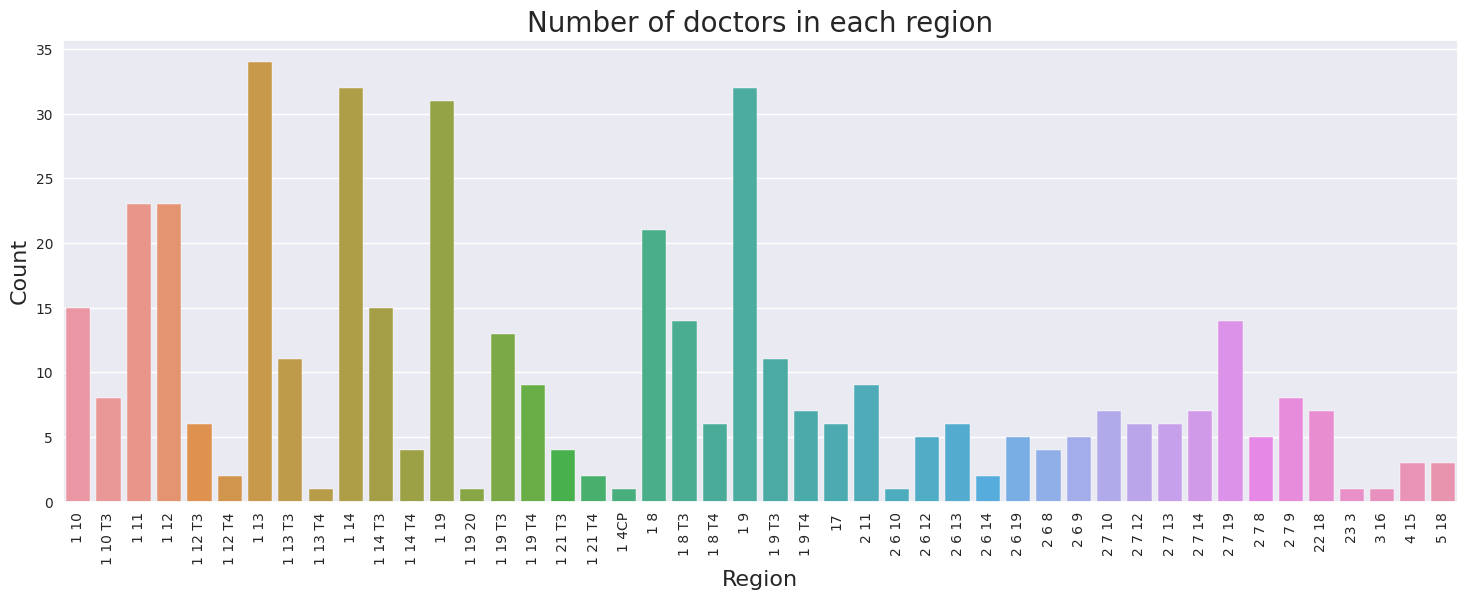
The barplot above compares the number of doctors in each region. Region 1 13 has the most number of doctors, followed by 1 9 and 1 14. The counts range from 1 to 34. The mean number of doctors across all regions is 10, while the median is 6. There is no observerable direct relationship between number of doctors and region.
3.2 What is the average number of purchases per region?#
We can find region and purchases information in the doctors table. We will perform a groupby operation to aggregate the average number of purchases in each region.
avg_purchases_per_region = doctors.groupby('Region')['Purchases'].mean().reset_index().rename({"Purchases": "Average purchases"}, axis=1)
display(avg_purchases_per_region.sort_values("Average purchases", ascending=False).head())
display(avg_purchases_per_region.describe())
| Region | Average purchases | |
|---|---|---|
| 13 | 1 19 20 | 129.000000 |
| 8 | 1 13 T4 | 30.000000 |
| 15 | 1 19 T4 | 25.333333 |
| 24 | 1 9 T4 | 23.428571 |
| 44 | 4 15 | 23.333333 |
| Average purchases | |
|---|---|
| count | 46.000000 |
| mean | 13.109296 |
| std | 18.662995 |
| min | 3.000000 |
| 25% | 5.035714 |
| 50% | 10.145722 |
| 75% | 14.000000 |
| max | 129.000000 |
# Plot region vs average number of purchases
plt.figure(figsize=(18,6))
sns.barplot(x="Region", y="Average purchases", data=avg_purchases_per_region)
plt.xticks(rotation=90)
plt.xlabel("Region", fontsize=16)
plt.ylabel("Average number of purchases", fontsize=16)
plt.title("Average number of purchases in each region", fontsize=20)
plt.show()
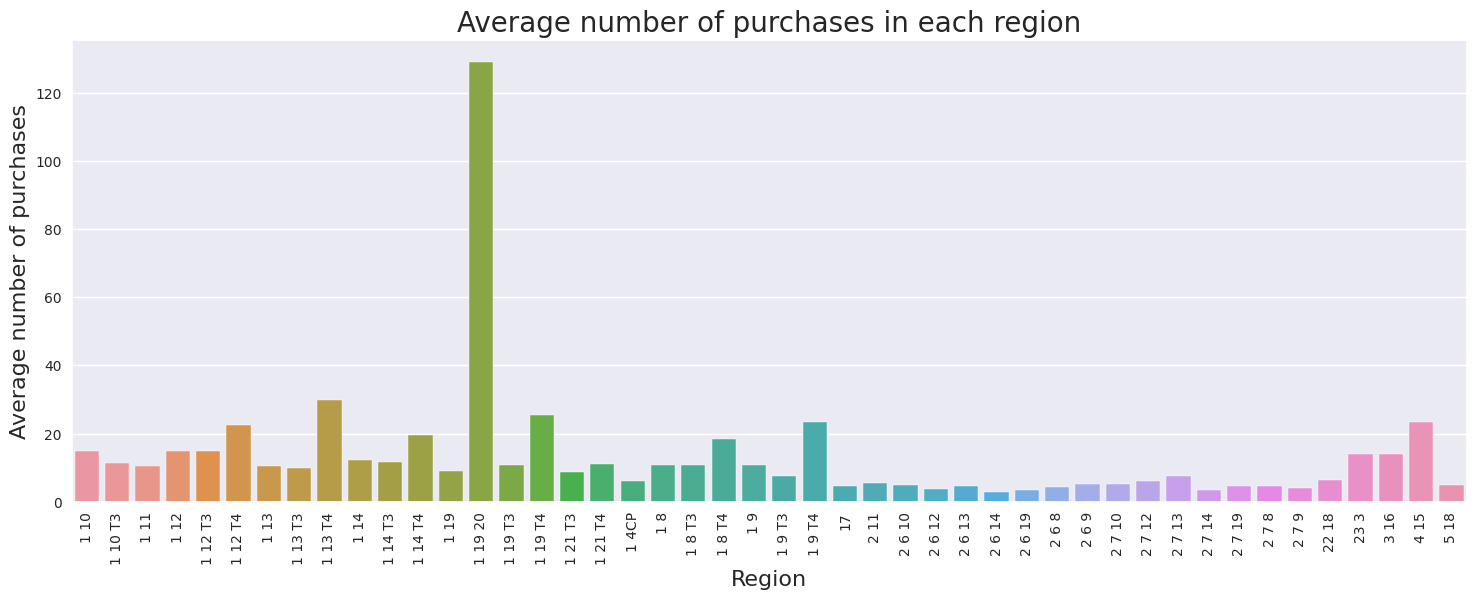
The barplot above compares the average number of purchases in each region. Region 1 19 20 has the highest average number of purchases of 129, however it can also be treated as a outlier because it is much larger than the other values in the dataset. The next highest region is 1 13 T4 with 30 average purchases. The average number of purchases range from 3 to 129. Across the dataset, the mean number of purchases across all region is 13, while the median is 10. There is no observerable direct relationship between number of purchases and region.
3.3 Can you find a relationship between purchases and complaints?#
Complaints information can be found complaints table. First let’s sum the quantity of complaints to DoctorID, then merge the complaints table with doctors table. There are also outliers, which are data values that are far away from other data values, which can strongly affect results. We will remove these outliers and calculate the correlation between the two variables.
# Group and sum compliants by DoctorID
complaints_group = complaints.groupby('DoctorID').sum().reset_index()
# Merge complaints table to doctors table
purchases_and_complaints = complaints_group.merge(doctors[["DoctorID", "Purchases"]], on="DoctorID").fillna(0)
# Remove outliers
remove_outliers(purchases_and_complaints)
display(purchases_and_complaints.head())
print(f"No. of instances where quantity of complaints were more than number of purchases {np.sum(purchases_and_complaints['Qty'] > purchases_and_complaints['Purchases'])}")
# Print correlation between Purchases and Qty of complaints
print(f"Correlation between purchases and quantity of complaints: {purchases_and_complaints['Qty'].corr(purchases_and_complaints['Purchases'])}")
# Plot Purchases vs Qty of complaints
plt.figure(figsize=(18,6))
sns.regplot(y='Qty', x='Purchases', data=purchases_and_complaints, truncate=False, x_jitter=.1)
plt.xlabel("Purchases", fontsize=16)
plt.ylabel("Quantity", fontsize=16)
plt.title("Purchases vs Quantity of Complaints", fontsize=20)
plt.show()
| DoctorID | Complaint Type | Qty | Purchases | |
|---|---|---|---|---|
| 0 | AAAEAH | Correct | 1 | 20.0 |
| 1 | AABDHC | Incorrect | 1 | 10.0 |
| 2 | AABGAB | CorrectUnknown | 4 | 4.0 |
| 3 | AADDIG | Incorrect | 1 | 5.0 |
| 4 | AAEIEG | CorrectIncorrectR&RUnknown | 2 | 11.0 |
No. of instances where quantity of complaints were more than number of purchases 7
Correlation between purchases and quantity of complaints: 0.01839142745208687
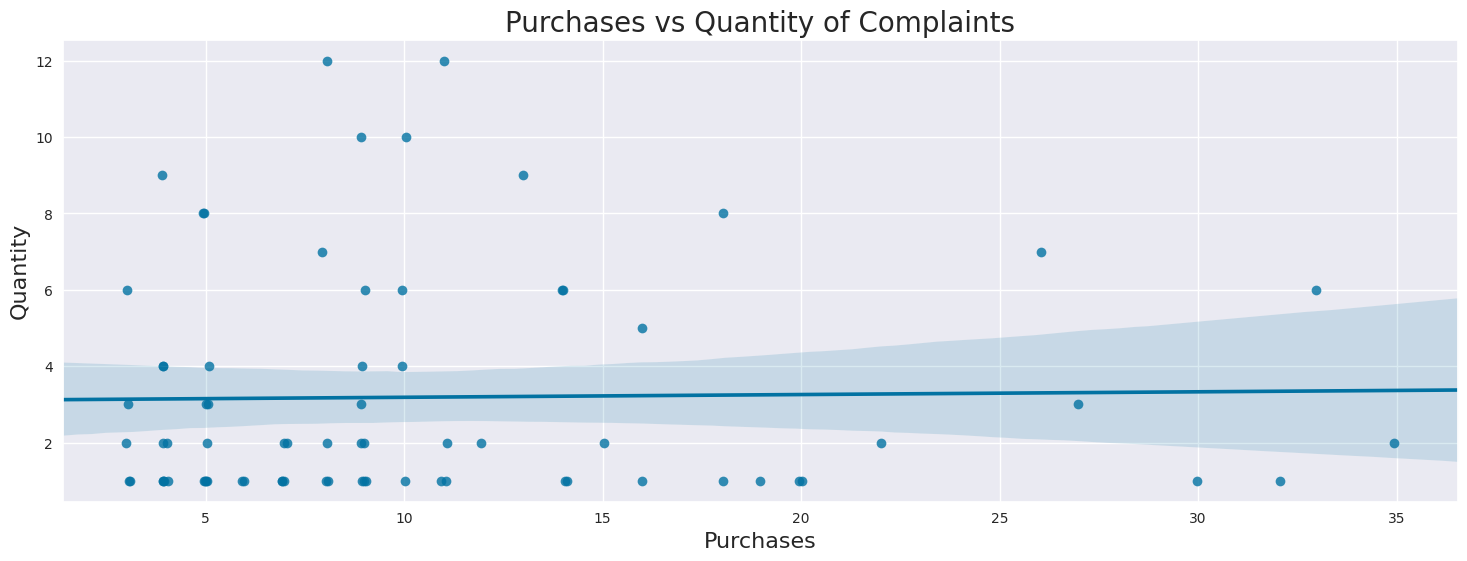
Pearson’s Correlation coefficient is a measure for the strength of a linear relationship between two variables. A coefficient between 0.3 and 0.5 is generally considered as weak, meaning that the two variables show no strong linear relationship. A coefficient between 0.5 and 0.7 is considered as moderate, whereas a correlation between 0.7 and 0.9 is considered strong. The correlation number and regression plot shows the no relationship between number of purchases and quantity of complaints.
There are also instances where quantity of complaints is greater than number of purchases. This could possibly be due to 1. Data Error 2. Multiple complaints regarding to same purchase 3. Complaints to purchases over a year ago since Purchases only contains data about purchases over the last year.
4 Exploratory Data Analysis (EDA)#
Let’s start by merging the four dataframes together. Next we will explore each column in the merged dataframe to better understand their type, distribution or frequency, and possible methods of addressing missing information.
Summary:
DoctorID,OrderID,OrderNumare IDs and will be dropped in modeling.Fill missing categorical variables with “Missing” or drop rows
Fill missing numerical variables with 0, impute with mean/median, or drop rows
Encode categorical variables
# list of dataframes to merge
data_frames = [doctors, orders, complaints, instructions]
df_merged = reduce(lambda left,right: pd.merge(left,right, how="outer", on=['DoctorID']), data_frames)
dqr(df_merged)
| DoctorID | Region | Category | Rank | Incidence rate | R rate | Satisfaction | Experience | Purchases | OrderID | ... | Condition C | Condition D | Condition F | Condition G | Condition H | Condition I | Condition J | Complaint Type | Qty | Instructions | |
|---|---|---|---|---|---|---|---|---|---|---|---|---|---|---|---|---|---|---|---|---|---|
| 0 | AHDCBA | 4 15 | Specialist | Ambassador | 49.0 | 0.90 | 53.85 | 1.20 | 49.0 | NaN | ... | NaN | NaN | NaN | NaN | NaN | NaN | NaN | NaN | NaN | Yes |
| 1 | ABHAHF | 1 8 T4 | General Practitioner | Ambassador | 37.0 | 0.00 | 100.00 | 0.00 | 38.0 | NaN | ... | NaN | NaN | NaN | NaN | NaN | NaN | NaN | NaN | NaN | NaN |
| 2 | FDHFJ | 1 9 T4 | Specialist | Ambassador | 33.0 | 1.53 | -- | 0.00 | 34.0 | NaN | ... | NaN | NaN | NaN | NaN | NaN | NaN | NaN | NaN | NaN | NaN |
| 3 | BJJHCA | 1 10 T3 | Specialist | Ambassador | 28.0 | 2.03 | -- | 0.48 | 29.0 | NaN | ... | NaN | NaN | NaN | NaN | NaN | NaN | NaN | NaN | NaN | NaN |
| 4 | FJBEA | 1 14 T4 | Specialist | Ambassador | 23.0 | 0.96 | 76.79 | 0.75 | 24.0 | NaN | ... | NaN | NaN | NaN | NaN | NaN | NaN | NaN | NaN | NaN | NaN |
5 rows × 23 columns
| count | mean | std | min | 25% | 50% | 75% | max | |
|---|---|---|---|---|---|---|---|---|
| Incidence rate | 786.0 | 4.8 | 3.5 | 2.0 | 3.0 | 4.0 | 5.6 | 49.0 |
| R rate | 786.0 | 1.2 | 0.8 | 0.0 | 0.8 | 1.0 | 1.5 | 4.2 |
| Experience | 786.0 | 0.6 | 0.5 | 0.0 | 0.2 | 0.6 | 0.8 | 5.4 |
| Purchases | 786.0 | 13.8 | 15.3 | 3.0 | 4.0 | 8.0 | 16.0 | 129.0 |
| Qty | 742.0 | 1.8 | 1.6 | 1.0 | 1.0 | 1.0 | 2.0 | 15.0 |
| Data Type | Records | Unique Values | Missing Values | Missing % | |
|---|---|---|---|---|---|
| DoctorID | object | 1105 | 647 | 0 | 0.00 |
| Region | object | 786 | 46 | 319 | 28.87 |
| Category | object | 786 | 2 | 319 | 28.87 |
| Rank | object | 784 | 9 | 321 | 29.05 |
| Incidence rate | float64 | 786 | 63 | 319 | 28.87 |
| R rate | float64 | 786 | 137 | 319 | 28.87 |
| Satisfaction | object | 786 | 99 | 319 | 28.87 |
| Experience | float64 | 786 | 106 | 319 | 28.87 |
| Purchases | float64 | 786 | 45 | 319 | 28.87 |
| OrderID | object | 434 | 249 | 671 | 60.72 |
| OrderNum | object | 434 | 248 | 671 | 60.72 |
| Condition A | object | 434 | 2 | 671 | 60.72 |
| Condition B | object | 434 | 2 | 671 | 60.72 |
| Condition C | object | 423 | 2 | 682 | 61.72 |
| Condition D | object | 434 | 2 | 671 | 60.72 |
| Condition F | object | 430 | 2 | 675 | 61.09 |
| Condition G | object | 430 | 2 | 675 | 61.09 |
| Condition H | object | 434 | 2 | 671 | 60.72 |
| Condition I | object | 434 | 2 | 671 | 60.72 |
| Condition J | object | 247 | 2 | 858 | 77.65 |
| Complaint Type | object | 740 | 5 | 365 | 33.03 |
| Qty | float64 | 742 | 12 | 363 | 32.85 |
| Instructions | object | 172 | 2 | 933 | 84.43 |
msno.bar(df_merged)
plt.show()
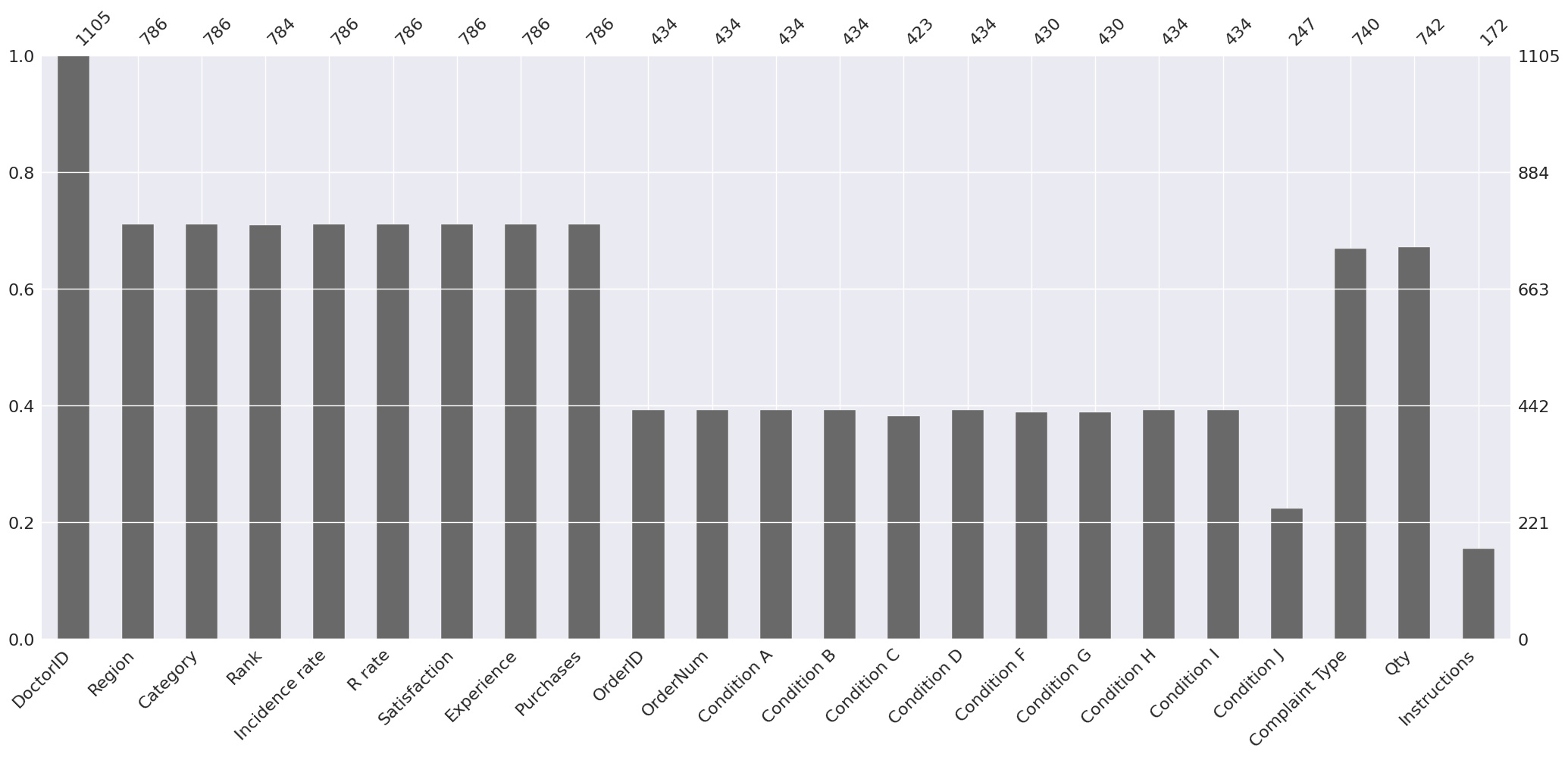
The y-axis scale ranges from 0.0 to 1.0, where 1.0 represents 100% data completeness. If the bar is less than this, it indicates that we have missing values within that column. DoctorID has 100% completeness while Instructions have the most number of missing values. This is expected because we used an outer join to merge the dataframes together.
4.1 Region#
Categorical variable
Convert missing values to “Missing” variable or drop those rows
Since each row represents a Doctor review 3.1 for mode and countplot of region.
display(df_merged["Region"].head())
0 4 15
1 1 8 T4
2 1 9 T4
3 1 10 T3
4 1 14 T4
Name: Region, dtype: object
4.2 Category#
Categorical variable, two categories: Specialist, or General Practitioner
Convert missing values to “Missing” variable or drop those rows
Most doctors are Specialists (707), only 79 doctors are General Practitioners
display(df_merged["Category"].head())
print("\n")
display(df_merged["Category"].unique())
print("\n")
display(df_merged["Category"].value_counts())
# Plot countplot of Category
plt.figure(figsize=(18,6))
sns.countplot(x="Category", data=df_merged)
plt.xlabel("Category", fontsize=16)
plt.ylabel("Count", fontsize=16)
plt.title("Count of each Category", fontsize=20)
plt.show()
0 Specialist
1 General Practitioner
2 Specialist
3 Specialist
4 Specialist
Name: Category, dtype: object
array(['Specialist', 'General Practitioner', nan], dtype=object)
Category
Specialist 707
General Practitioner 79
Name: count, dtype: int64
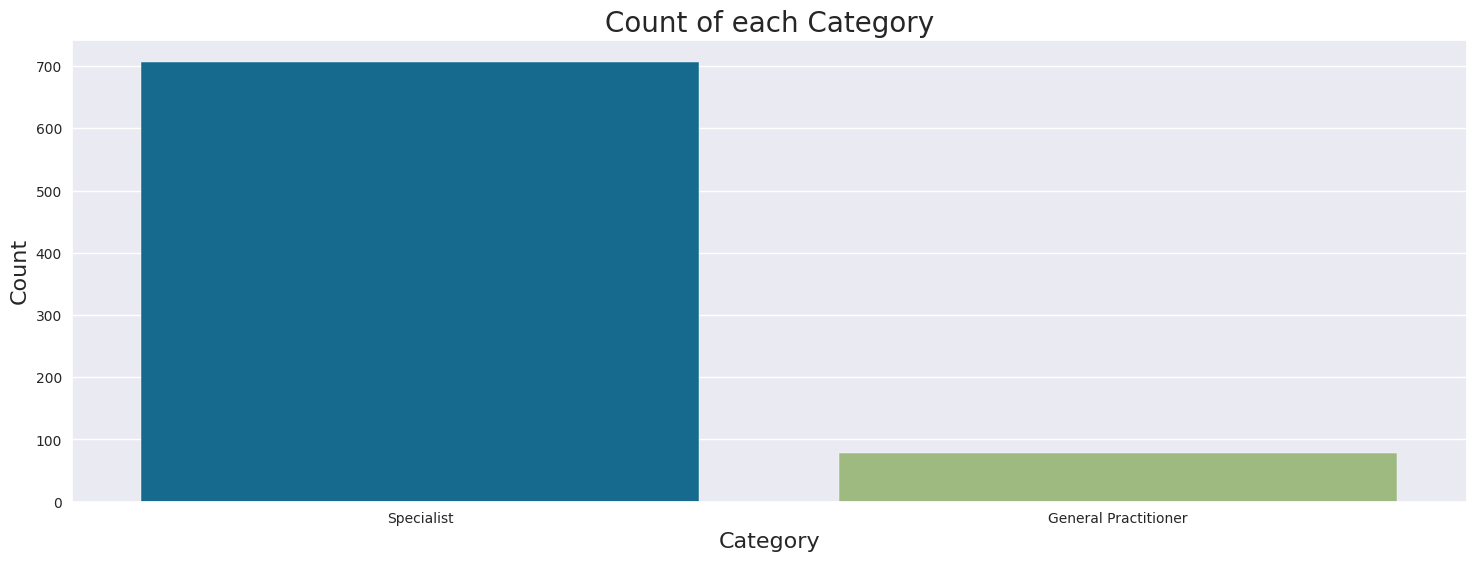
4.3 Rank#
Ordered Categorical variable, there are nine categories.
The highest rank is Ambassadors, followed by Titanium Plus, Titanium, Platinum Plus, Platinum, Gold Plus, Gold, Silver Plus, and the lowest level is Silver.
Data imbalance, only 1 Doctor is Rank Titanium Plus
Most common rank is Ambassador, least common Titanium Plus
Use ordinal encoding, where missing will be -1. However, this assumes that the numerical distance between each set of subsequent rank is equal.
display(df_merged["Rank"].head())
print("\n")
display(df_merged["Rank"].unique())
print("\n")
display(df_merged["Rank"].value_counts())
# Plot countplot of Rank
plt.figure(figsize=(18,6))
sns.countplot(x="Rank", data=df_merged)
plt.xlabel("Rank", fontsize=16)
plt.ylabel("Count", fontsize=16)
plt.title("Count of each Rank", fontsize=20)
plt.show()
0 Ambassador
1 Ambassador
2 Ambassador
3 Ambassador
4 Ambassador
Name: Rank, dtype: object
array(['Ambassador', 'Platinum Plus', 'Titanium', 'Silver Plus', 'Gold',
'Platinum', 'Gold Plus', 'Silver', nan, 'Titanium Plus'],
dtype=object)
Rank
Ambassador 277
Platinum 146
Titanium 128
Gold Plus 79
Platinum Plus 73
Silver Plus 50
Gold 27
Silver 3
Titanium Plus 1
Name: count, dtype: int64
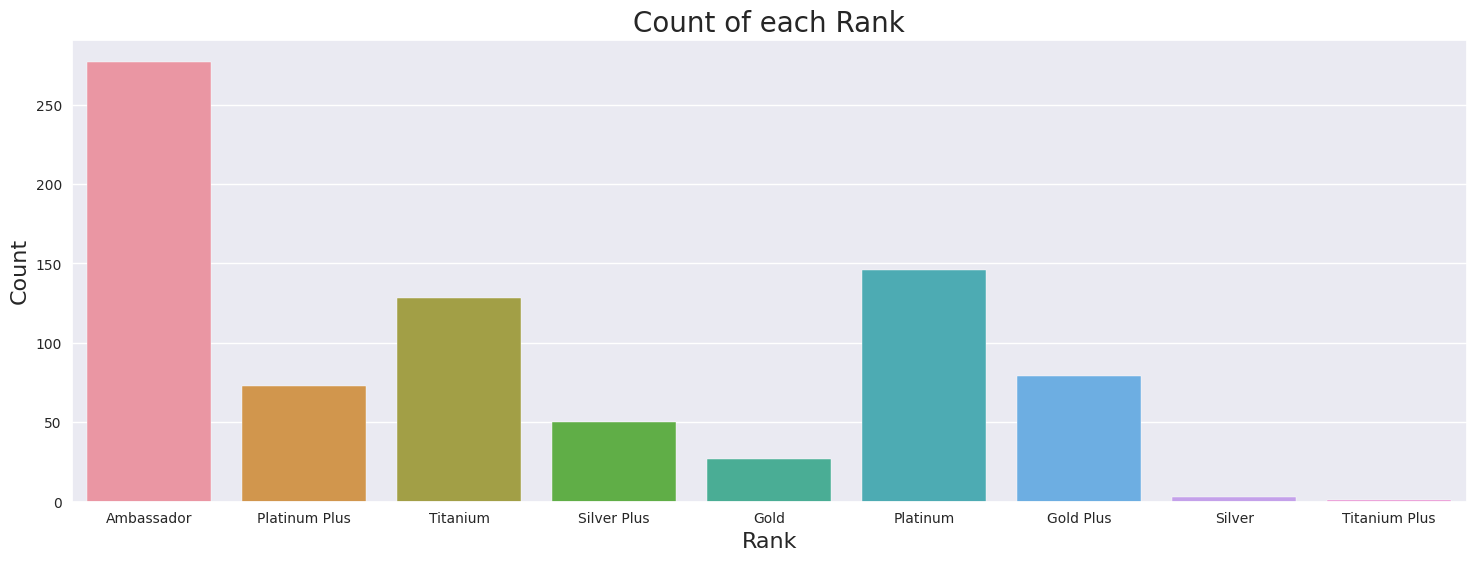
4.4 Incidence rate#
Numerical variable
Impute missing values with 0 or drop rows
Right skewed distribution ranging from 2 to 29 with a median of 4.
Apply log transformer to handle skewness
Possible outliers as seen in the boxplot, however will be kept because there is no indication this is incorrectly entered or measured data,
display(df_merged["Incidence rate"].head())
print(f'Meidan: {df_merged["Incidence rate"].quantile(0.5)}')
print(f'Skew: {df_merged["Incidence rate"].skew()}')
# Creating a figure composed of two matplotlib.Axes objects (ax_box and ax_hist)
f, (ax_box, ax_hist) = plt.subplots(2, sharex=True, gridspec_kw={"height_ratios": (.15, .85)}, figsize=(18,6))
sns.set(font_scale = 1.5)
# Assigning a graph to each ax
sns.boxplot(x="Incidence rate", data=df_merged, ax=ax_box)
sns.histplot(x="Incidence rate", data=df_merged, ax=ax_hist)
# Remove x axis name for the boxplot
ax_box.set(xlabel='', title="Boxplot and Histogram of Incidence rate")
ax_hist.set(xlabel="Incidence rate", ylabel="Frequency")
plt.show()
0 49.0
1 37.0
2 33.0
3 28.0
4 23.0
Name: Incidence rate, dtype: float64
Meidan: 4.0
Skew: 5.607171363436355
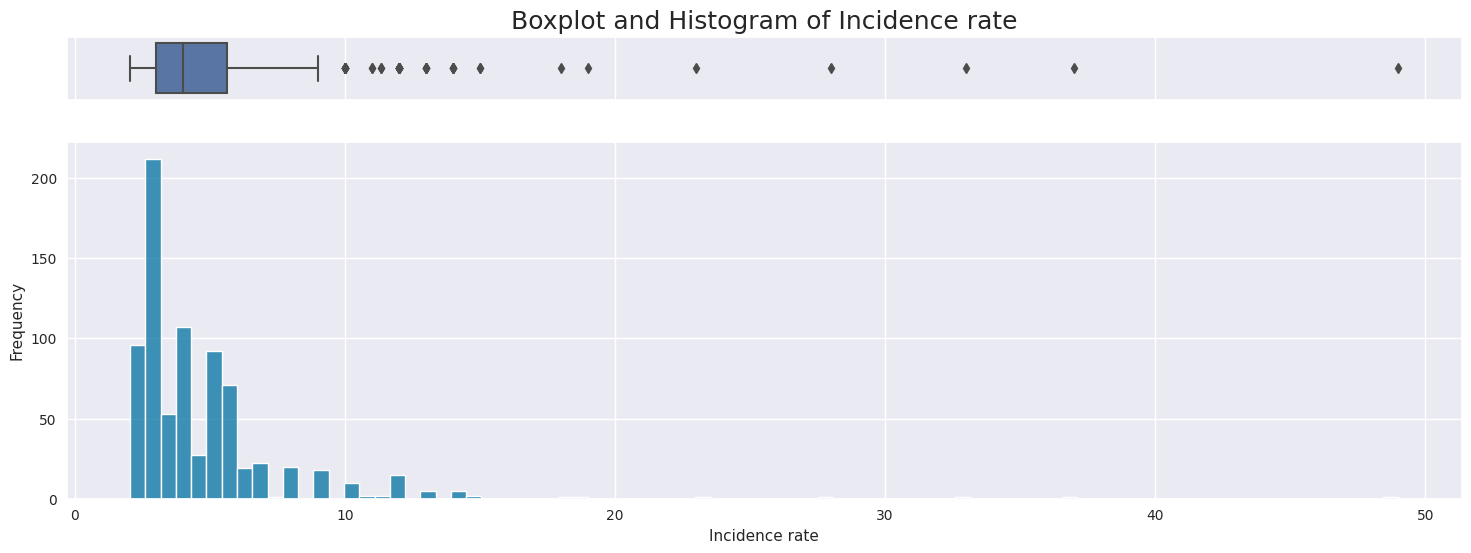
print(f'Skew of default: {df_merged["Incidence rate"].skew()}')
print(f'Skew of log transform: {np.log(df_merged["Incidence rate"]).skew()}')
print(f'Skew of square-root transform: {np.sqrt(df_merged["Incidence rate"]).skew()}')
print(f'Skew of cube-root transform: {np.cbrt(df_merged["Incidence rate"]).skew()}')
# Plot histogram of logged Incidence rate
plt.figure(figsize=(18,6))
sns.histplot(np.log(df_merged["Incidence rate"]), bins=12)
plt.xlabel("Incidence rate", fontsize=16)
plt.ylabel("Frequency", fontsize=16)
plt.title("Histogram of logged Incidence rate", fontsize=20)
plt.show()
Skew of default: 5.607171363436355
Skew of log transform: 1.2241053607140613
Skew of square-root transform: 2.619246516085647
Skew of cube-root transform: 2.025533508846419
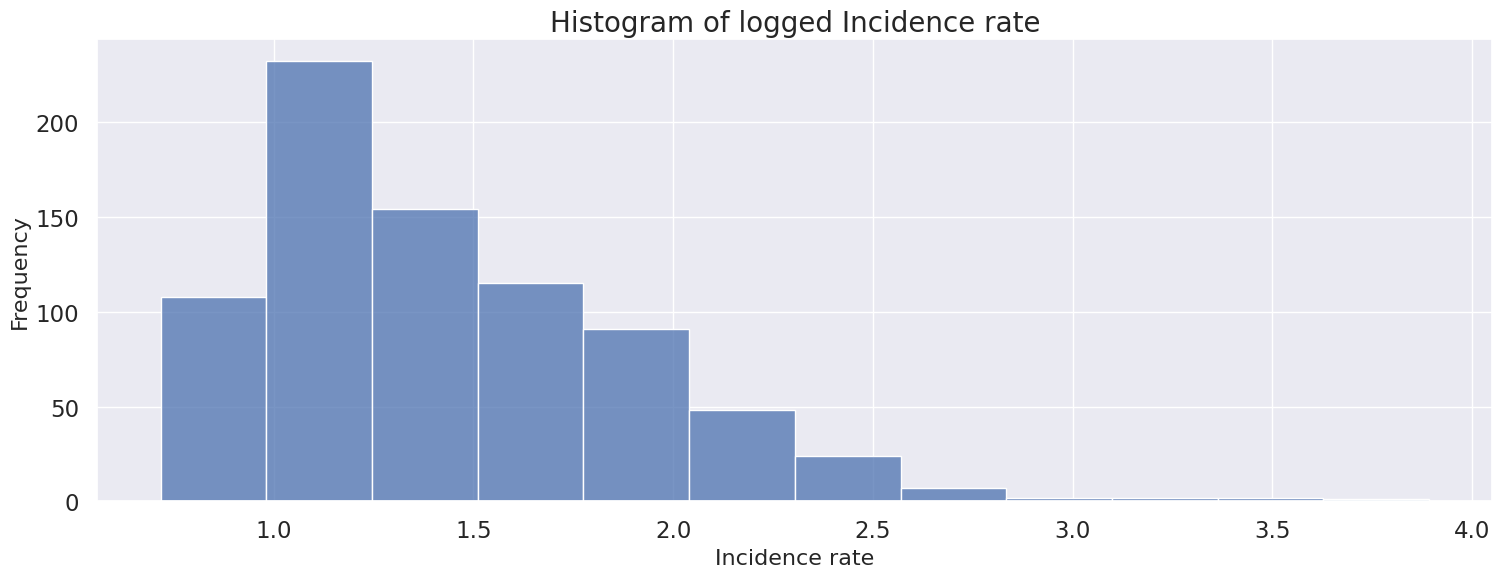
4.5 R rate#
Numerical variable
Only positive values
Impute missing values with 0 or drop rows
Right skewed distribution ranging from 0 to 4.2 with a median of 1.
Possible outliers as seen in the boxplot, however will be kept because there is no indication this is incorrectly entered or measured data,
display(df_merged["R rate"].head())
print(f'Meidan: {df_merged["R rate"].quantile(0.5)}')
print(f'Skew: {df_merged["R rate"].skew()}')
# Creating a figure composed of two matplotlib.Axes objects (ax_box and ax_hist)
f, (ax_box, ax_hist) = plt.subplots(2, sharex=True, gridspec_kw={"height_ratios": (.15, .85)}, figsize=(18,6))
sns.set(font_scale = 1.5)
# Assigning a graph to each ax
sns.boxplot(x="R rate", data=df_merged, ax=ax_box)
sns.histplot(x="R rate", data=df_merged, ax=ax_hist, bins=16)
# Remove x axis name for the boxplot
ax_box.set(xlabel='', title="Boxplot and Histogram of R rate")
ax_hist.set(xlabel="R rate", ylabel="Frequency")
plt.show()
0 0.90
1 0.00
2 1.53
3 2.03
4 0.96
Name: R rate, dtype: float64
Meidan: 1.0
Skew: 1.8086653960068204
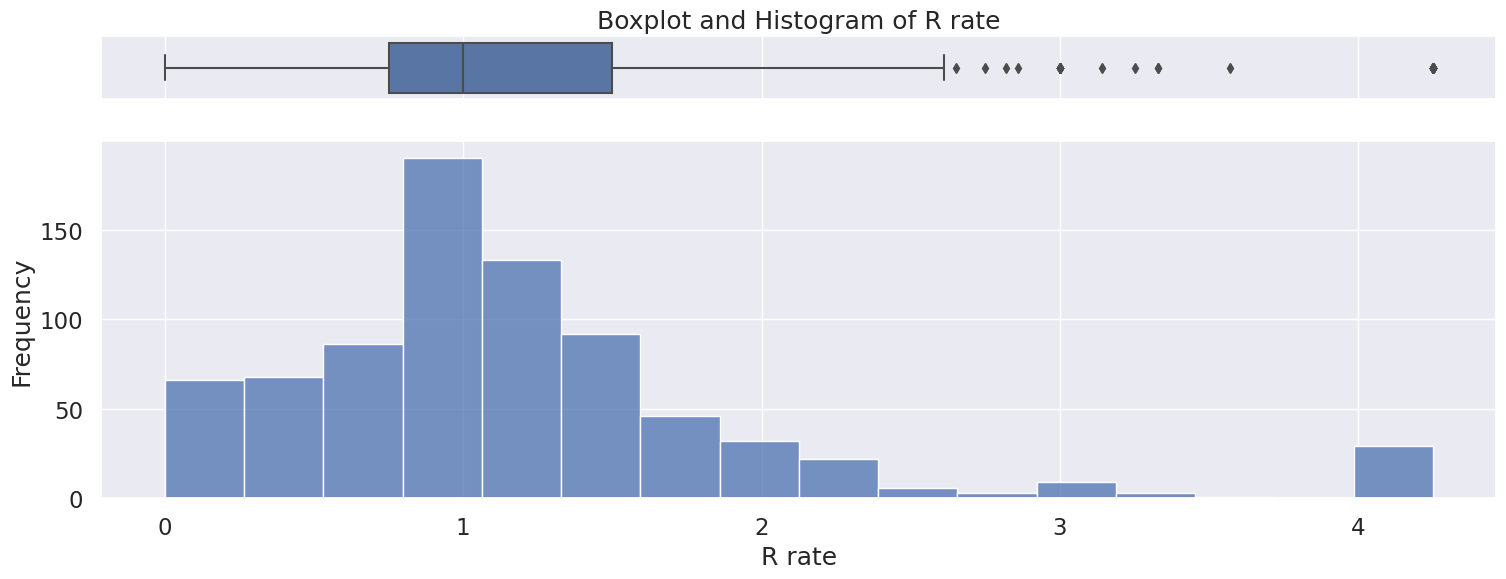
4.6 Satisfaction#
Numerical variable, spanning from -100 to 100
Contains some – characters, fill missing values with 0 or drop rows
When removing the “–” characters from the column, we see a left skewed distribution of the doctor’s satisfaction with the company.
The relation between mean, median, and mode is Mean < Median < Mode.
# Filter rows in Satisfaction that match --
dashes = doctors["Satisfaction"] == "--"
print(f"No. of dashes in Satisfaction: {sum(dashes)}")
# Remove dashes
satisfaction = doctors[~dashes]["Satisfaction"].astype(float)
satisfaction_med = satisfaction.quantile(0.5)
print(f'Skew: {pd.Series(satisfaction).skew()}')
display(satisfaction.describe())
# Creating a figure composed of two matplotlib.Axes objects (ax_box and ax_hist)
f, (ax_box, ax_hist) = plt.subplots(2, sharex=True, gridspec_kw={"height_ratios": (.15, .85)}, figsize=(18,6))
sns.set(font_scale = 1.5)
# Assigning a graph to each ax
sns.boxplot(satisfaction, ax=ax_box)
sns.histplot(satisfaction, ax=ax_hist)
# Remove x axis name for the boxplot
ax_box.set(xlabel='', title="Boxplot and Histogram of doctors' satisfaction with the company")
ax_hist.set(xlabel="Satisfaction", ylabel="Frequency")
plt.show()
No. of dashes in Satisfaction: 187
Skew: -0.662765167744903
count 250.000000
mean 29.218720
std 61.225893
min -100.000000
25% -12.315000
50% 39.230000
75% 83.330000
max 100.000000
Name: Satisfaction, dtype: float64
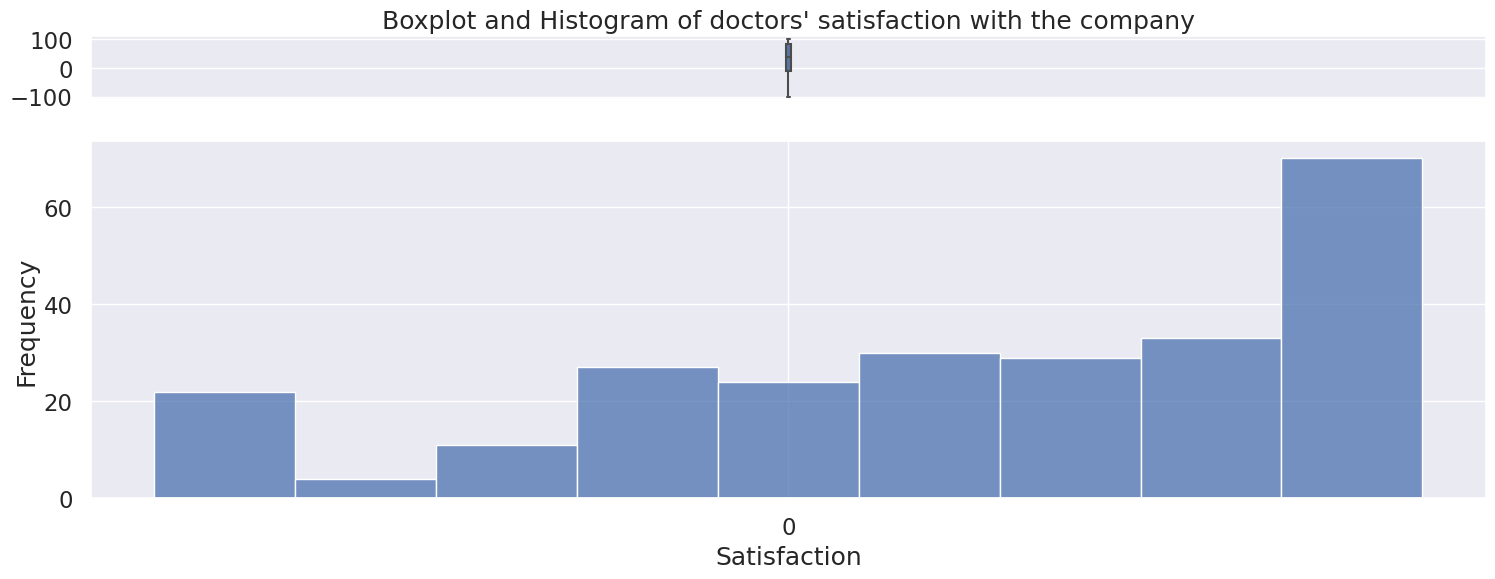
4.7 Experience#
Numerical variable
Only positive values as expected
Fill missing value with 0 or drop rows
Right skewed distribution ranging from 0 to 5.4, with a median of 0.57.
Possible outliers as seen in the boxplot, however will be kept because there is no indication this is incorrectly entered or measured data,
display(df_merged["Experience"].head())
print(f'Meidan: {df_merged["Experience"].quantile(0.5)}')
print(f'Skew: {df_merged["Experience"].skew()}')
# Creating a figure composed of two matplotlib.Axes objects (ax_box and ax_hist)
f, (ax_box, ax_hist) = plt.subplots(2, sharex=True, gridspec_kw={"height_ratios": (.15, .85)}, figsize=(18,6))
sns.set(font_scale = 1.5)
# Assigning a graph to each ax
sns.boxplot(x="Experience", data=df_merged, ax=ax_box)
sns.histplot(x="Experience", data=df_merged, ax=ax_hist)
# Remove x axis name for the boxplot
ax_box.set(xlabel='', title="Boxplot and Histogram of Experience")
ax_hist.set(xlabel="Experience", ylabel="Frequency")
plt.show()
0 1.20
1 0.00
2 0.00
3 0.48
4 0.75
Name: Experience, dtype: float64
Meidan: 0.57
Skew: 2.711810861459008
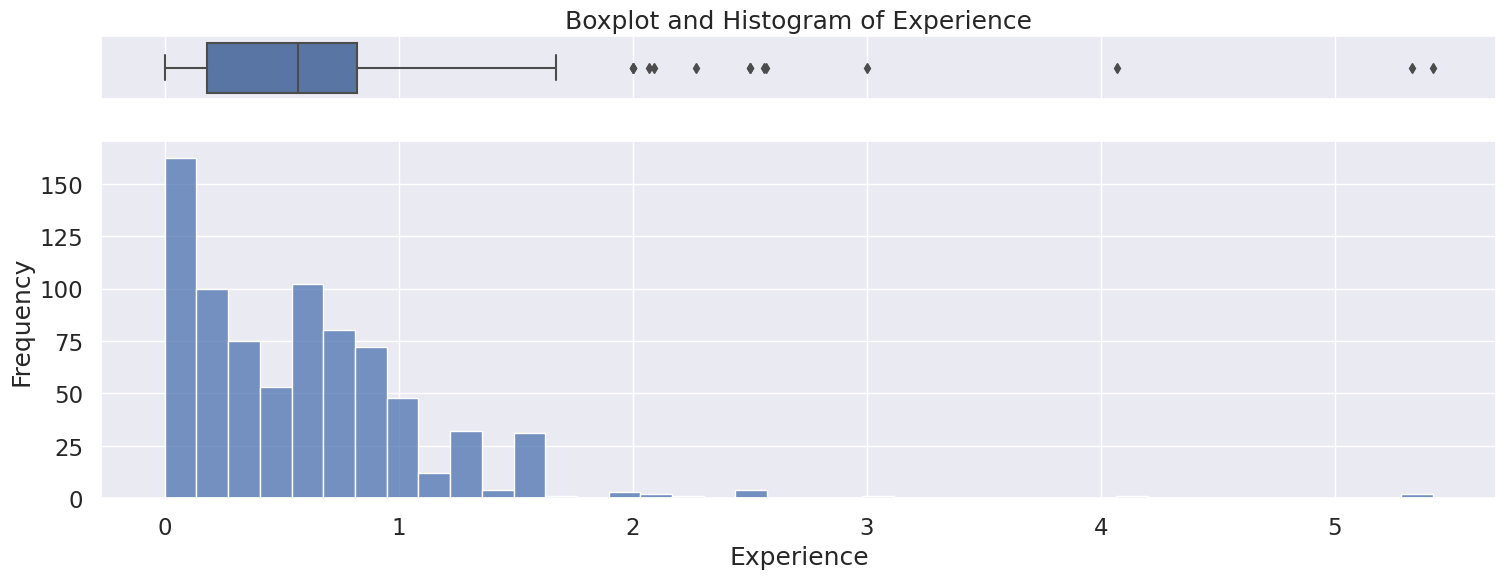
4.8 Purchases#
Discrete Numerical variable
Only positive values as expected
Fill missing value with 0 or drop rows
Right skewed distribution ranging from 3 to 129 with a median of 8.
Possible outliers as seen in the boxplot, however will be kept because there is no indication this is incorrectly entered or measured data,
display(df_merged["Purchases"].head())
print(f'Meidan: {df_merged["Purchases"].quantile(0.5)}')
print(f'Skew: {df_merged["Purchases"].skew()}')
# Creating a figure composed of two matplotlib.Axes objects (ax_box and ax_hist)
f, (ax_box, ax_hist) = plt.subplots(2, sharex=True, gridspec_kw={"height_ratios": (.15, .85)}, figsize=(18,6))
sns.set(font_scale = 1.5)
# Assigning a graph to each ax
sns.boxplot(x="Purchases", data=df_merged, ax=ax_box)
sns.histplot(x="Purchases", data=df_merged, ax=ax_hist)
# Remove x axis name for the boxplot
ax_box.set(xlabel='', title="Boxplot and Histogram of Purchases")
ax_hist.set(xlabel="Purchases", ylabel="Frequency")
plt.show()
0 49.0
1 38.0
2 34.0
3 29.0
4 24.0
Name: Purchases, dtype: float64
Meidan: 8.0
Skew: 2.8726322076942634
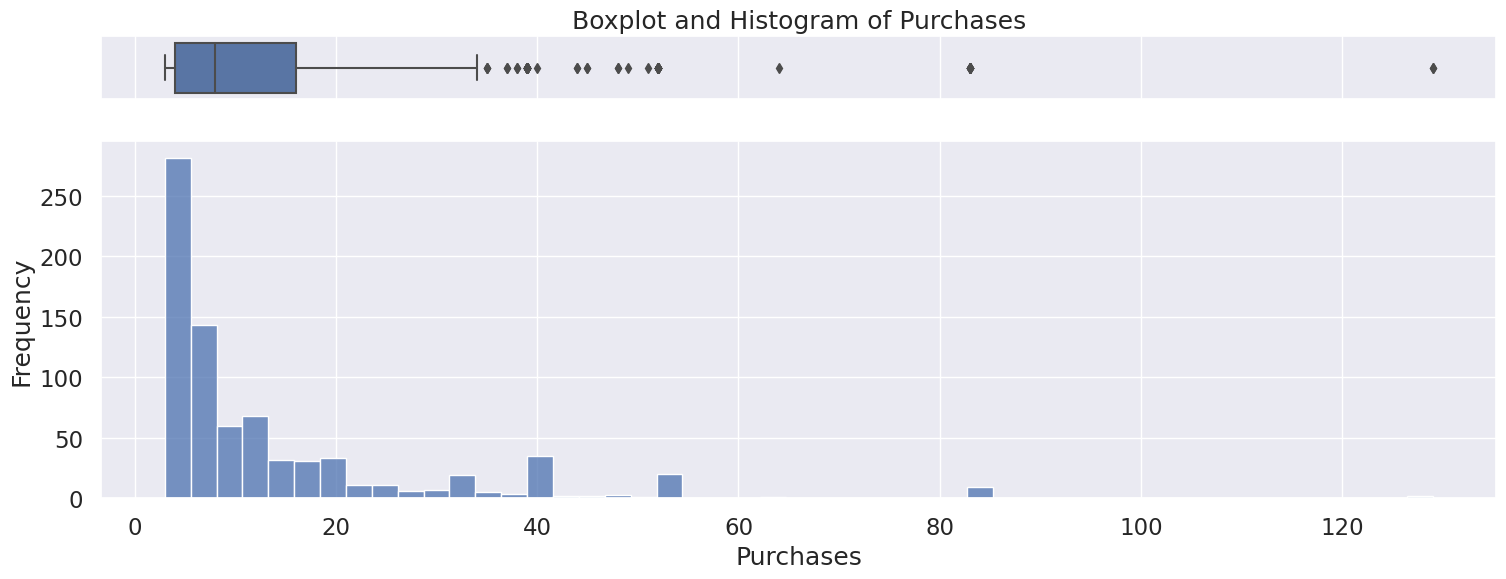
4.9 Condition A-J#
No Condition E
Boolean variable
Condition A-H are True, False
Condition J are Before, After
Fill missing variables with mode, or drop rows
Encode to 0 and 1
# Plot subplots of Condition A-J
fig, axs = plt.subplots(2, 5, figsize=(18,10))
fig.suptitle('Count of each Condition')
sns.countplot(x="Condition A", data=df_merged, ax=axs[0, 0])
sns.countplot(x="Condition B", data=df_merged, ax=axs[0, 1])
sns.countplot(x="Condition C", data=df_merged, ax=axs[0, 2])
sns.countplot(x="Condition D", data=df_merged, ax=axs[0, 3])
axs[0, 4].axis('off')
sns.countplot(x="Condition F", data=df_merged, ax=axs[1, 0])
sns.countplot(x="Condition G", data=df_merged, ax=axs[1, 1])
sns.countplot(x="Condition H", data=df_merged, ax=axs[1, 2])
sns.countplot(x="Condition I", data=df_merged, ax=axs[1, 3])
sns.countplot(x="Condition J", data=df_merged, ax=axs[1, 4])
plt.show()
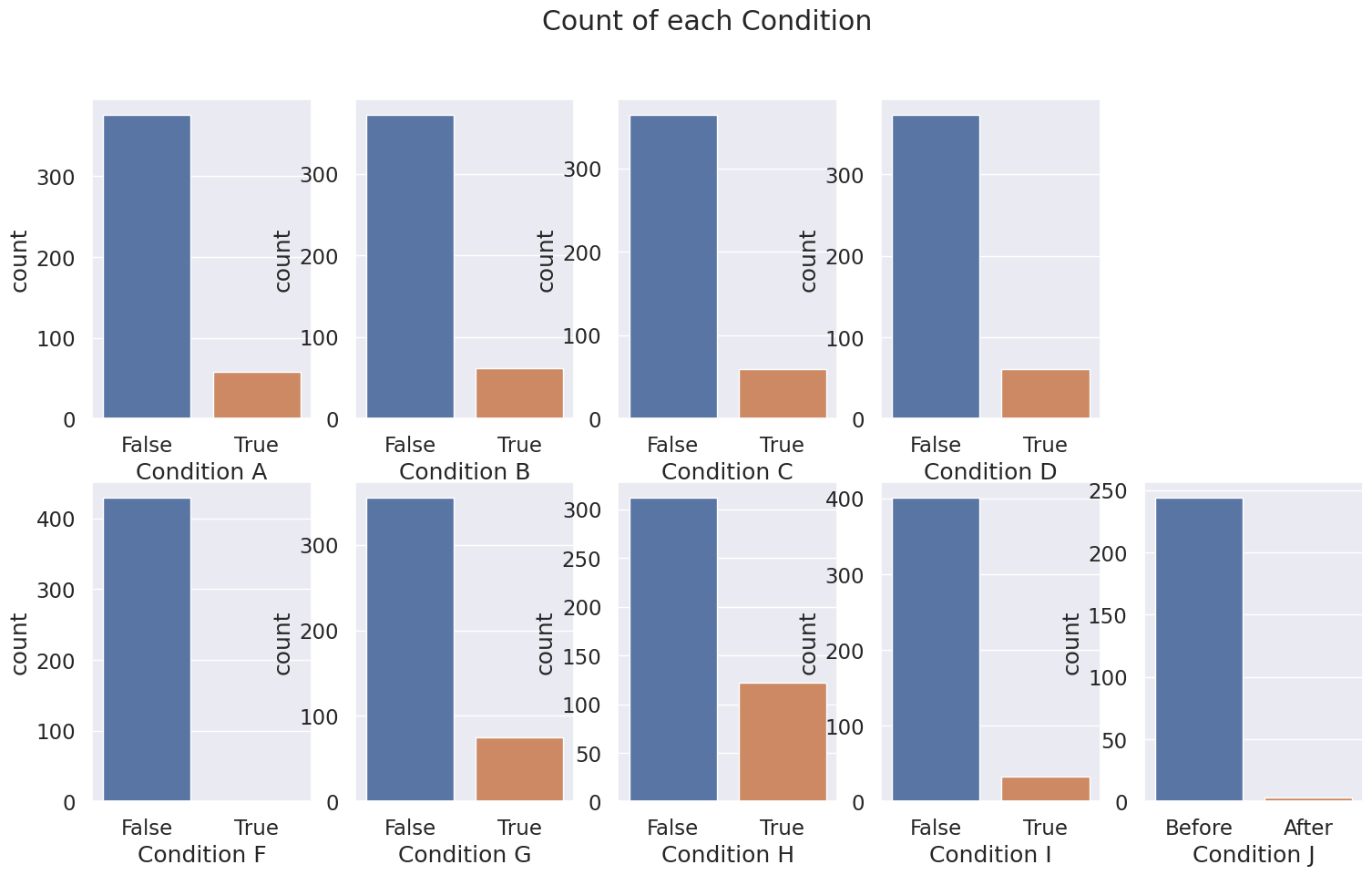
4.10 Complaint Type#
Categorical variable
Most common complaint type is “Correct”
Convert missing values to “Missing” variable or drop those rows
display(df_merged["Complaint Type"].value_counts())
# Plot countplot of Complaint Type
plt.figure(figsize=(18,6))
sns.countplot(x="Complaint Type", data=df_merged)
plt.xlabel("Complaint Type", fontsize=16)
plt.ylabel("Count", fontsize=16)
plt.title("Count of each Complaint Type", fontsize=20)
plt.show()
Complaint Type
Correct 355
Incorrect 220
Unknown 152
Specific 11
R&R 2
Name: count, dtype: int64
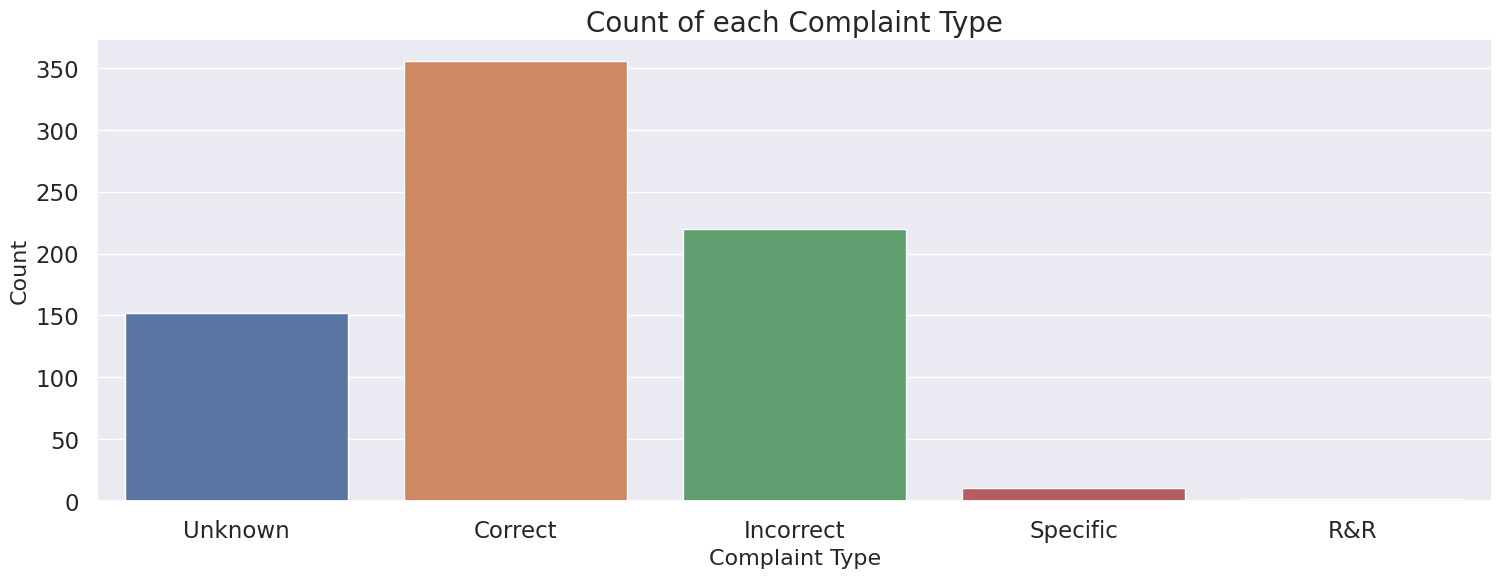
4.11 Qty#
Discrete numerical variable
Right skewed distribution, ranging from 1 to 15.
Fill missing with 0 or drop rows
Possible outliers as seen in the boxplot, however will be kept because there is no indication this is incorrectly entered or measured data,
# Creating a figure composed of two matplotlib.Axes objects (ax_box and ax_hist)
f, (ax_box, ax_hist) = plt.subplots(2, sharex=True, gridspec_kw={"height_ratios": (.15, .85)}, figsize=(18,6))
sns.set(font_scale = 1.5)
# Assigning a graph to each ax
sns.boxplot(x="Qty", data=df_merged, ax=ax_box)
sns.histplot(x="Qty", data=df_merged, ax=ax_hist)
# Remove x axis name for the boxplot
ax_box.set(xlabel='', title="Boxplot and Histogram of Qty")
ax_hist.set(xlabel="Qty", ylabel="Frequency")
plt.show()
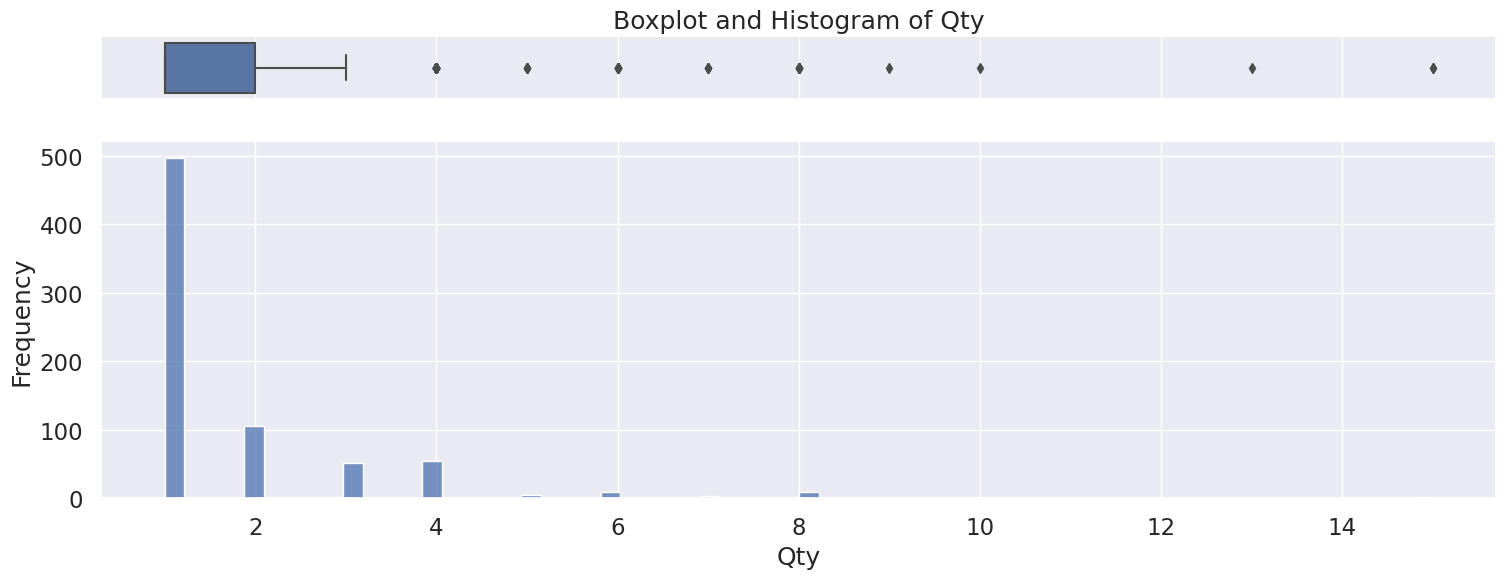
4.12 Instructions#
Binary variable
Fill missing with “No”
Encode to 0, 1
# Plot countplot of Instructions
plt.figure(figsize=(18,6))
sns.countplot(x="Instructions", data=df_merged)
plt.xlabel("Instructions", fontsize=16)
plt.ylabel("Count", fontsize=16)
plt.title("Count of each Instructions", fontsize=20)
plt.show()
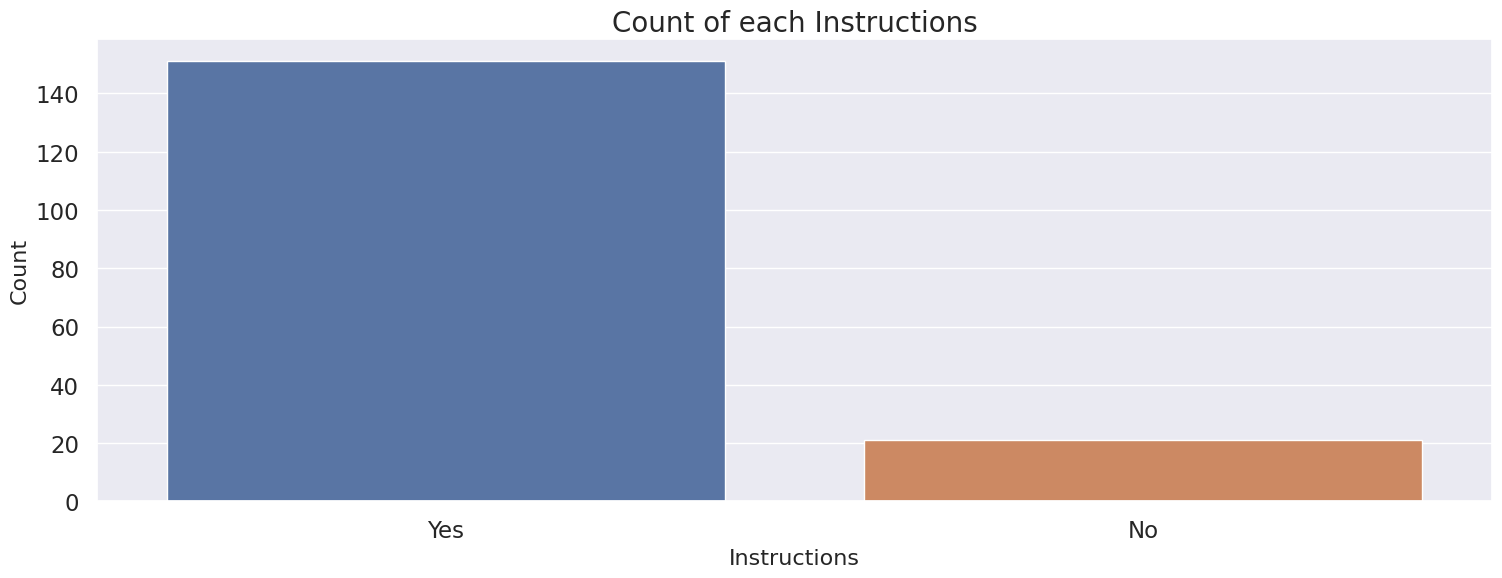
5 Feature Selection and Engineering#
Based on our EDA, we recognize the dataset contains a mixture of identifier, categorical and continuous data, as well as missing values. We will now perform data preprocessing.
# List of numerical columns
num_cols = ['Incidence rate', 'R rate', 'Satisfaction', 'Experience', 'Purchases', 'Qty']
# List of categorical columns that could be one hot encoded
cat_cols = ["Region", "Category", "Complaint Type"]
5.1 Dropping identifiers, filling missing values, and encoding#
Drop ID columns
Fill in missing values
One hot encoding categorical variables
Ordinal encoding on Rank
Label Encoding on binary variables
Change type of column as approriate
# Create function to perform preprocessing on dataframe
def preproc(df):
"""
Perform preprocessing (drop columns, fill missing values, encode columns) on dataframe
ARGS:
df (dataframe): Pandas dataframe
OUTPUT:
Preprocessed dataframe
"""
# Drop ID columns
df.drop(["DoctorID", "OrderID", "OrderNum"], axis=1, inplace=True)
# Fill missing Region values
df["Region"].fillna("Missing", inplace=True)
df["Region"] = df["Region"].astype("category")
# Fill missing Category values
df["Category"].fillna("Missing", inplace=True)
# Ordinal Encode Rank values, fill missing with -1
df["Rank"] = df["Rank"].map({'Silver': 0,
'Silver Plus': 1,
'Gold': 2,
'Gold Plus': 3,
'Platinum': 4,
'Platinum Plus': 5,
'Titanium': 6,
'Titanium Plus': 7,
'Ambassador': 8})
df["Rank"].fillna(-1, inplace=True)
# Fill missing Incidence rate values
df["Incidence rate"] = df["Incidence rate"].fillna(0).astype(float)
# Fill missing R rate values
df["R rate"] = df["R rate"].fillna(0).astype(float)
# Replace -- rows, and fill missing Satifactions values with 0
df["Satisfaction"] = df["Satisfaction"].replace("--", 0)
df["Satisfaction"] = df["Satisfaction"].fillna("0").astype(float)
# Fill missing Experience values
df["Experience"] = df["Experience"].fillna(0).astype(float)
# Fill missing Purchases values
df["Purchases"] = df["Purchases"].fillna(0).astype(float)
# Encode boolean columns
enc = Pipeline(steps=[
("encoder", OrdinalEncoder()),
("imputer", SimpleImputer(strategy="constant", fill_value=0)),
])
df[["Condition A",
"Condition B",
"Condition C",
"Condition D",
"Condition F",
"Condition G",
"Condition H",
"Condition I"]] = enc.fit_transform(df[["Condition A",
"Condition B",
"Condition C",
"Condition D",
"Condition F",
"Condition G",
"Condition H",
"Condition I"]])
# Encode Condition J, fill mising with -1
df["Condition J"] = df["Condition J"].map({"Before": 0,
"After": 1
})
df["Condition J"].fillna(-1, inplace=True)
# Fill missing Complaint Type values
df["Complaint Type"].fillna("Missing", inplace=True)
# Fill missing Qty values
df["Qty"] = df["Qty"].fillna(0).astype(float)
# Encode Instructions, fill mising with 0
df["Instructions"] = df["Instructions"].map({"No": 0,
"Yes": 1
})
df["Instructions"].fillna(0, inplace=True)
# One hot encoding on categorical columns
df = pd.get_dummies(df, columns=cat_cols)
return df
processed_df = df_merged.copy()
processed_df = preproc(processed_df)
display(processed_df.columns)
print(f"Number of features: {len(processed_df.columns)}")
processed_df.head()
Index(['Rank', 'Incidence rate', 'R rate', 'Satisfaction', 'Experience',
'Purchases', 'Condition A', 'Condition B', 'Condition C', 'Condition D',
'Condition F', 'Condition G', 'Condition H', 'Condition I',
'Condition J', 'Qty', 'Instructions', 'Region_1 10', 'Region_1 10 T3',
'Region_1 11', 'Region_1 12', 'Region_1 12 T3', 'Region_1 12 T4',
'Region_1 13', 'Region_1 13 T3', 'Region_1 13 T4', 'Region_1 14',
'Region_1 14 T3', 'Region_1 14 T4', 'Region_1 19', 'Region_1 19 20',
'Region_1 19 T3', 'Region_1 19 T4', 'Region_1 21 T3', 'Region_1 21 T4',
'Region_1 4CP', 'Region_1 8', 'Region_1 8 T3', 'Region_1 8 T4',
'Region_1 9', 'Region_1 9 T3', 'Region_1 9 T4', 'Region_17',
'Region_2 11', 'Region_2 6 10', 'Region_2 6 12', 'Region_2 6 13',
'Region_2 6 14', 'Region_2 6 19', 'Region_2 6 8', 'Region_2 6 9',
'Region_2 7 10', 'Region_2 7 12', 'Region_2 7 13', 'Region_2 7 14',
'Region_2 7 19', 'Region_2 7 8', 'Region_2 7 9', 'Region_22 18',
'Region_23 3', 'Region_3 16', 'Region_4 15', 'Region_5 18',
'Region_Missing', 'Category_General Practitioner', 'Category_Missing',
'Category_Specialist', 'Complaint Type_Correct',
'Complaint Type_Incorrect', 'Complaint Type_Missing',
'Complaint Type_R&R', 'Complaint Type_Specific',
'Complaint Type_Unknown'],
dtype='object')
Number of features: 73
| Rank | Incidence rate | R rate | Satisfaction | Experience | Purchases | Condition A | Condition B | Condition C | Condition D | ... | Region_Missing | Category_General Practitioner | Category_Missing | Category_Specialist | Complaint Type_Correct | Complaint Type_Incorrect | Complaint Type_Missing | Complaint Type_R&R | Complaint Type_Specific | Complaint Type_Unknown | |
|---|---|---|---|---|---|---|---|---|---|---|---|---|---|---|---|---|---|---|---|---|---|
| 0 | 8.0 | 49.0 | 0.90 | 53.85 | 1.20 | 49.0 | 0.0 | 0.0 | 0.0 | 0.0 | ... | False | False | False | True | False | False | True | False | False | False |
| 1 | 8.0 | 37.0 | 0.00 | 100.00 | 0.00 | 38.0 | 0.0 | 0.0 | 0.0 | 0.0 | ... | False | True | False | False | False | False | True | False | False | False |
| 2 | 8.0 | 33.0 | 1.53 | 0.00 | 0.00 | 34.0 | 0.0 | 0.0 | 0.0 | 0.0 | ... | False | False | False | True | False | False | True | False | False | False |
| 3 | 8.0 | 28.0 | 2.03 | 0.00 | 0.48 | 29.0 | 0.0 | 0.0 | 0.0 | 0.0 | ... | False | False | False | True | False | False | True | False | False | False |
| 4 | 8.0 | 23.0 | 0.96 | 76.79 | 0.75 | 24.0 | 0.0 | 0.0 | 0.0 | 0.0 | ... | False | False | False | True | False | False | True | False | False | False |
5 rows × 73 columns
5.2 Feature Scaling#
Using MinMaxScaler to make sure features with different scales don’t introduce bias into clustering
# Scale numerical features
scaler = MinMaxScaler()
scaled_df = processed_df.copy()
scaled_df[num_cols] = pd.DataFrame(MinMaxScaler().fit_transform(scaled_df[num_cols]),
index=scaled_df.index)
5.3 Principal Component Analysis (PCA)#
This method is used to reduce the dimensionality of the dataset. Let have set up a loop function to identify number of principal components that explain at least 85% of the variance in the dataset.
RANDOM_STATE = 23
# Loop Function to identify number of principal components that explain at least 85% of the variance
for comp in range(2, scaled_df.shape[1]):
pca = PCA(n_components=comp, random_state=RANDOM_STATE)
pca.fit(scaled_df)
comp_check = pca.explained_variance_ratio_
n_comp = comp
if comp_check.sum() > 0.85:
break
pca = PCA(n_components=n_comp, random_state=RANDOM_STATE)
pca_df = pd.DataFrame(pca.fit_transform(scaled_df), index=scaled_df.index)
num_comps = comp_check.shape[0]
print("Using {} components, we can explain {}% of the variability in the original data.".format(n_comp, comp_check.sum()*100))
pca_df.head()
Using 2 components, we can explain 87.06746784108557% of the variability in the original data.
| 0 | 1 | |
|---|---|---|
| 0 | -4.474670 | -0.669163 |
| 1 | -4.334824 | -0.723871 |
| 2 | -4.443076 | -0.706745 |
| 3 | -4.443955 | -0.714453 |
| 4 | -4.441273 | -0.707036 |
6 Define new doctor segments#
Our objective is to help the company improve their marketing efforts and customer service by creating new doctor segments from an unlabeled dataset, hence an unsupervised machine learning and clustering appears to be the most reasonable choice of the model. Clustering divides a set of objects or observations (in this case doctors) into different groups based on their features or properties. The division is done in such that the observations are as similar as possible to each other within the same cluster. In addition, each cluster should be as far away from the others as possible.
6.1 Optimal number of clusters#
We will use the elbow method to determe the optimal number of clusters. The method calculates the Within-Cluster-Sum of Squared Errors (WSS) for different number of clusters (k) and selecting the k for which change in WSS first starts to diminish.
Based on the distortion score at different k, 5 is the optimal number of clusters.
# Elbow method using yellowbrick library
plt.figure(figsize=(18,6))
model = KMeans()
# k is range of number of clusters.
visualizer = KElbowVisualizer(model, k=(2,20), timings= True)
visualizer.fit(pca_df)
visualizer.show()
plt.show()
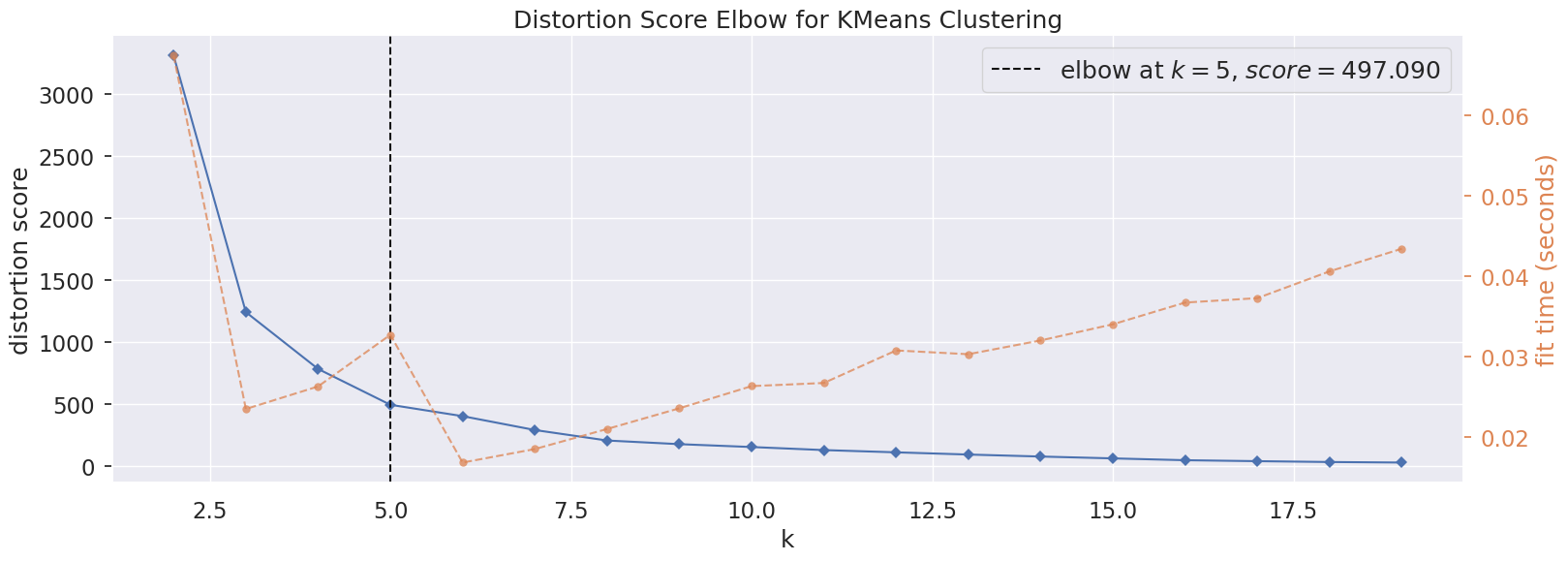
6.2 KMeans clustering#
KMeans is an iterative algorithm that partitions the dataset into K pre-defined distinct non-overlapping subgroups (clusters) where each data point belongs to only one group.
The graph shows the scatter plot of the data colored by the cluster they belong to based on their similarity.
k = 5
km = KMeans(n_clusters=k, random_state=RANDOM_STATE).fit(pca_df)
label = km.labels_
# Getting unique labels
u_labels = np.unique(label)
plt.figure(figsize=(18,6))
for i in u_labels:
plt.scatter(pca_df.iloc[label == i, 0] , pca_df.iloc[label == i, 1] , label = i)
plt.legend()
plt.xlabel("PCA 1")
plt.ylabel("PCA 2")
plt.title("Visualization of clustered data")
plt.show()
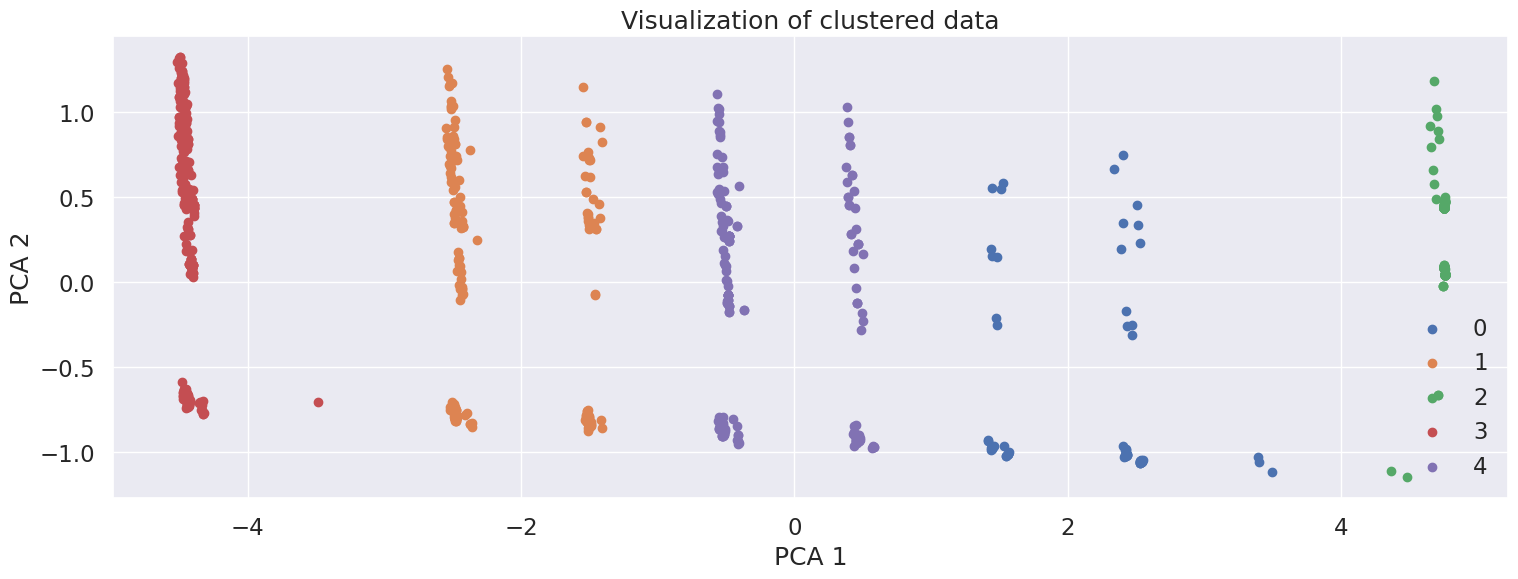
6.3 Which features impact the new segmentation strategy the most#
Now that we have identified our clusters, let’s extract each cluster’s most important features. One approach is to convert the unsupervised clustering problem into a One-vs-All supervised classification problem.
Change the cluster labels into One-vs-All binary labels
Train a classifier to discriminate between each cluster and all other clusters
Extract the feature importances from the model (We will be using sklearn.ensemble.RandomForestClassifier)
From the weights we identify Rank as the most important feature, this is usually followed by purchases and R rate.
scaled_df["Cluster"] = label
scaled_df['Binary Cluster 0'] = scaled_df['Cluster'].map({0:1, 1:0, 2:0, 3:0, 4:0})
scaled_df['Binary Cluster 1'] = scaled_df['Cluster'].map({0:0, 1:1, 2:0, 3:0, 4:0})
scaled_df['Binary Cluster 2'] = scaled_df['Cluster'].map({0:0, 1:0, 2:1, 3:0, 4:0})
scaled_df['Binary Cluster 3'] = scaled_df['Cluster'].map({0:0, 1:0, 2:0, 3:1, 4:0})
scaled_df['Binary Cluster 4'] = scaled_df['Cluster'].map({0:0, 1:0, 2:0, 3:0, 4:1})
# Train a classifier
from sklearn.ensemble import RandomForestClassifier
scaled_df_train = scaled_df.drop(["Cluster", "Binary Cluster 0", "Binary Cluster 1", "Binary Cluster 2", "Binary Cluster 3", "Binary Cluster 4"], axis=1)
for i in range(5):
clf = RandomForestClassifier(random_state=RANDOM_STATE)
clf.fit(scaled_df_train.values, scaled_df["Binary Cluster " + str(i)].values)
# Index sort the most important features
sorted_feature_weight_idxes = np.argsort(clf.feature_importances_)[::-1] # Reverse sort
# Get the most important features names and weights
most_important_features = np.take_along_axis(np.array(scaled_df_train.columns.tolist()), sorted_feature_weight_idxes, axis=0)
most_important_weights = np.take_along_axis(np.array(clf.feature_importances_), sorted_feature_weight_idxes, axis=0)
# Show
print(list(zip(most_important_features, most_important_weights))[:3])
[('Rank', 0.3462422263806552), ('R rate', 0.060365456749001456), ('Category_General Practitioner', 0.05741863343778913)]
[('Rank', 0.36374424881372586), ('Purchases', 0.08363203178543055), ('Region_1 8 T3', 0.06992636245787862)]
[('Rank', 0.16906243640382515), ('Category_Missing', 0.16547351972134908), ('Purchases', 0.16081255501034938)]
[('Rank', 0.44233890242367024), ('Purchases', 0.16679337117408138), ('R rate', 0.06584395381200006)]
[('Rank', 0.3689971859520564), ('Purchases', 0.10372479238158124), ('R rate', 0.09107045419109543)]
7 Characteristics that distinguish the newly defined segments#
Now that we have identified new doctor segments, let’s identify their characteristics.
Each cluster contains the following groups of Ranks:
Silver, Silver Plus, Gold
Gold Plus, “Platinum
Platinum Plus, Titanium
Titanium Plus, Ambassador
Missing
Let’s also explore whether other columns have any relationships with feature Rank. By calculating the pairwise correlation, we see that it suggests a strong positive relationship with Purchases, and a moderate positive relationship with Incidence rate, R rate. We can dismiss Category_Specialist, because as seen in 4.2, most doctors are categorized as specialists.
cluster_df = scaled_df.copy()
# Groupby cluster
display(cluster_df.groupby("Cluster")["Rank"].value_counts())
# Rank's correlation with other columns
rank_corr = scaled_df_train.corrwith(scaled_df['Rank']).reset_index().sort_values(0, ascending=False).rename({"index": "Column", 0: "Correlation"}, axis=1)
display(rank_corr.head(5))
Cluster Rank
0 1.0 50
2.0 27
0.0 3
1 6.0 128
5.0 73
2 -1.0 321
3 8.0 277
7.0 1
4 4.0 146
3.0 79
Name: count, dtype: int64
| Column | Correlation | |
|---|---|---|
| 0 | Rank | 1.000000 |
| 66 | Category_Specialist | 0.797082 |
| 5 | Purchases | 0.631280 |
| 1 | Incidence rate | 0.526836 |
| 2 | R rate | 0.441926 |
7.1 Rank vs Purchases#
From the violin plot, we can see there is a positive relationship between Rank and Purchases, where the higher Ranks have a higher number of purchases. This is also seen in the median number of purchases of each rank, with the exception of Silver Rank. Therefore, Rank is helpful indicator in predicting the number of purchases a doctor will make. Ambassador Rank has the highest number of purchases, with a high of 129 purchases. Titanium Plus looks like an outlier on the violin plot, but this can be attributed to having a small sample size of doctors in that rank.
rank_order = ['Silver',
'Silver Plus',
'Gold',
'Platinum',
'Platinum Plus',
'Titanium',
'Titanium Plus',
'Ambassador']
rank_df = df_merged.copy()
# Calculate median for each rank group
print("Median number of Purchases by Rank")
display(rank_df.groupby("Rank")["Purchases"].median().reindex(rank_order))
print("Max number of Purchases by Rank")
display(rank_df.groupby("Rank")["Purchases"].max().reindex(rank_order))
plt.figure(figsize=(18,6))
ax = sns.violinplot(x="Rank", y="Purchases", data=df_merged, order=rank_order)
plt.title("Violin plot of Purchases based on Rank")
plt.show()
Median number of Purchases by Rank
Rank
Silver 7.0
Silver Plus 4.0
Gold 3.0
Platinum 5.0
Platinum Plus 7.0
Titanium 10.0
Titanium Plus 14.0
Ambassador 20.0
Name: Purchases, dtype: float64
Max number of Purchases by Rank
Rank
Silver 8.0
Silver Plus 14.0
Gold 14.0
Platinum 16.0
Platinum Plus 24.0
Titanium 45.0
Titanium Plus 14.0
Ambassador 129.0
Name: Purchases, dtype: float64
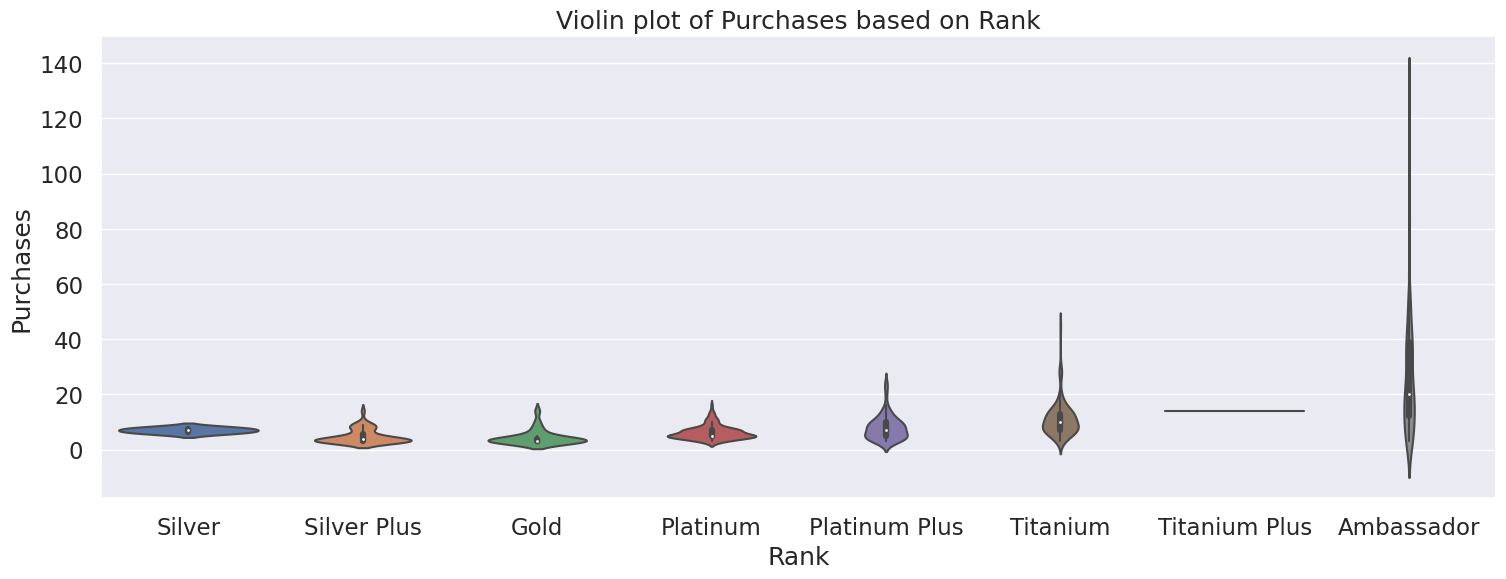
7.2 Rank vs Incidence rate and R rate#
On the other hand, it is less certain whether there is a clear trend between Rank and Incidence rate or Rank and R rate. Therefore, Rank is a moderate indicator on the amount of rework a doctor generates.
# Calculate median for each rank group
display(rank_df.groupby("Rank")["Incidence rate"].median().reindex(rank_order))
display(rank_df.groupby("Rank")["R rate"].median().reindex(rank_order))
Rank
Silver 7.0
Silver Plus 3.0
Gold 3.0
Platinum 5.0
Platinum Plus 4.0
Titanium 4.0
Titanium Plus 2.5
Ambassador 4.0
Name: Incidence rate, dtype: float64
Rank
Silver 1.13
Silver Plus 0.33
Gold 1.00
Platinum 1.25
Platinum Plus 1.25
Titanium 1.20
Titanium Plus 1.64
Ambassador 0.85
Name: R rate, dtype: float64
8. Conclusion#
From our analysis in 3.2 we consider that grouping doctors by geography is a poor predictor of the number of purchases a doctor will make or their support needs. In addition, there is no relationship between number of purchases and number of complaints as seen in 3.3.
We move to use a data-centric approach to segment the doctors by using unsupervised machine learning to cluster them based on their features from the tables Doctors, Orders, Complaints, Instructions. The model we use for clustering is KMeans and it has grouped the doctors into 5 clusters as seen in section 6. We find that Rank impacts the new segmentation strategy the most and also detect a positive relationship between Rank and Purchases.
Clusters based on Rank:
Silver, Silver Plus, Gold
Gold Plus, “Platinum
Platinum Plus, Titanium
Titanium Plus, Ambassador
Missing
In conclusion, we recommend the company to base their marketing efforts and customer services based on Rank, which is their internal ranking system.
Weaknesses:
Though it is unknown how a doctor’s
Rankis generated. While, it is a good predictor for the number a doctor will make, it is not a direct indicator of their support needs.While Ordinal encoding of Rank captured the ordering of the variable, it assumes that each rank is of equal distance to each other. Perhaps the gap between Titanium and Titanium Plus is small, however the jump to Ambassador is much larger etc. and the encoding does not represent that.
8.1 Next steps#
To build upon this analysis, we recommend doing the following:
Understand how
Rankis generatedMore data collection to address data imbalance, and reduce proportion of missing values.
Further feature engineering and selection, e.g. explore other ways of imputing missing values.
Explore different clustering models besides KMeans. Drawbacks to KMeans include being unable to handle noisy data and outliers, as well as not being suitable to identify clusters with non-convex shapes.
Alternatives to interpreting the clusters (our approach was using a Random Forest Classifier)

